- Contact Contact icon Contact
- Training Training icon Training

- Portuguese, Brazil
- Chinese, Simplified
Check the spelling in your query or search for a new term.
Site search accepts advanced operators to help refine your query. Learn more.

Congratulations to the 2024 CAS Future Leaders
Announcing the 2024 CAS Future Leaders! This group of exceptional Ph.D. students and postdoctoral scholars from around the world will take the next steps in their leadership journeys this August in Columbus, Ohio, and Denver, Colorado.

2024 CAS Future Leaders

This year's participants were selected from among hundreds of highly qualified applicants, representing a wide array of scientific disciplines and organizations from around the world. Congratulations to our 2024 class:
Aziz Abu-Saleh , University of Windsor, Canada Noah Bartfield , Yale University, United States Michelle Brann , Harvard & Smithsonian Center for Astrophysics, United States Rosemary L. Calabro , U.S. Army DEVCOM Armaments Center and United States Military Academy, United States Xiangkun (Elvis) Cao , Massachusetts Institute of Technology, United States Áine Coogan , Trinity College Dublin, Ireland Chiara Deriu , Politecnico di Torino, Italy Madison Elaine Edwards , Texas A&M University, United States Olga Eremina , University of Southern California, United States Inès Forrest , Scripps Research Institute, United States Patrick W. Fritz , University of Fribourg, Switzerland Nabojit Kar , Indiana University Bloomington, United States Stavros Kariofillis , Columbia University, United States Joshua Kofsky , Queen's University, Canada Eric Kohn , University of Wisconsin-Madison, United States Danielle Maxwell , University of Michigan, United States Keita Mori , Tokyo University of Agriculture and Technology, Japan Aditya Nandy , University of Chicago, United States Akachukwu Obi , Massachusetts Institute of Technology, United States Ernest Opoku , Auburn University, United States Daisy Pooler , KTH Royal Institute of Technology, Sweden Pragti , Indian Institute of Technology Indore, India Stephanie Schneider , McMaster University, Canada Ekaterina Selivanovitch , Cornell University, United States Hanchen Shen , Hong Kong University of Science and Technology, China Lilian Sophie Szych , Freie Universität Berlin, Germany Alexander Umanzor , University of Minnesota, Twin Cities, United States Ken Aldren Usman , Institute for Frontier Materials, Deakin University - Waurn Ponds, Australia Sara T. R. Velasquez , University of Twente, Netherlands Gayatri Viswanathan , Iowa State University, United States Kunyu Wang , University of Pennsylvania, United States Athi Welsh , University of Cape Town, South Africa Kyra Yap , Stanford University, United States Yirui Zhang , Stanford University, United States Junyi Zhao , Washington University in St. Louis, United States
Join our global network of Ph.D. students and postdoctoral scholars in chemistry and related sciences.
Testimonials, "beyond learning life lessons and skills from top leaders in the chemical industry, participating in future leaders gave me the opportunity to connect with inspiring scientists from all over the world, creating strong friendships with remarkable individuals who continue to be a source of support and motivation long after finishing the program.".
—César A. Urbina-Blanco (2018), C&EN
"For a group of young scientists, strangers to one another, working in such diverse areas of chemical sciences, we connected on a level that no one had ever expected." —Felicia Lim (2018), CAS Blog
"Being part of the Future Leaders transforms your life. You never forget the moment you get that email from CAS. But more importantly, you never forget the people you meet during the program." —Fernando Gomollon Bel (2014), CAS Blog
Why You Should Apply
The CAS Future Leaders program supports the growth of science leadership among early-career scientists. Since 2010, the program has awarded Ph.D. students and postdoctoral scholars opportunities to learn leadership skills, engage in scientific discourse, and connect with peer scientists and innovators from around the world.
Get exclusive leadership training from industry experts and learn how CAS connects the world’s scientific knowledge.
Share your latest discoveries to advance scientific knowledge at the American Chemical Society fall meeting.
Network to make meaningful connections with peer scientists and innovators from around the world.
2024 CAS Future Leaders Benefits
The 2024 CAS Future Leaders Top 100 program recognizes additional outstanding applicants from our call for applications. This new initiative honors their accomplishments and provides exclusive Top 100 benefits to support the growth of their science leadership potential.
2024 CAS Future Leaders Top 100 Benefits
Frequently asked questions, am i eligible to apply .
You must be a current Ph.D. student (or plan to be enrolled in a Ph.D. program in 2024) or postdoctoral scholar in chemistry or related science, with a working knowledge of multiple research information tools.
How do you define “postdoctoral scholar”?
We consider a postdoctoral scholar as an individual who has received a doctoral degree (or equivalent) and is engaged in a temporary period of mentored advanced training to enhance the professional skills and research independence needed to pursue their chosen career path.
Questions about the CAS Future Leaders program? See our FAQ and Terms & Conditions or email the CAS Future Leaders team.

What matters most? Eight CEO priorities for 2024

Analyzing the CEO–CMO relationship and its effect on growth
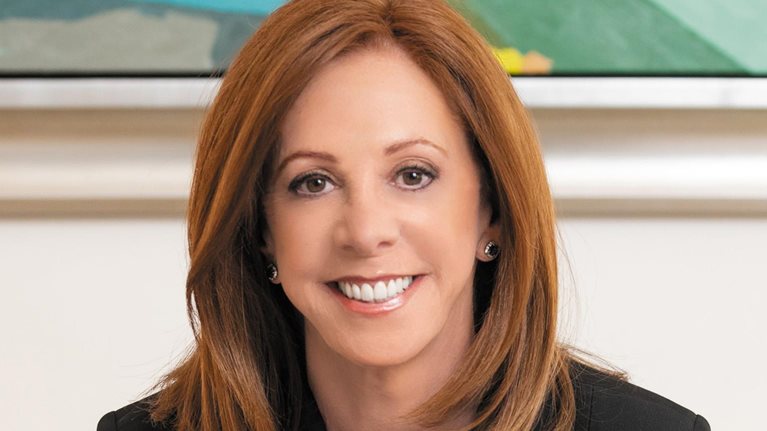
The Exchange: Making the energy transition real with Tamara Lundgren

Travel Disruptors: Capturing B2B growth

How to prepare for the CEO role
Featured publications.
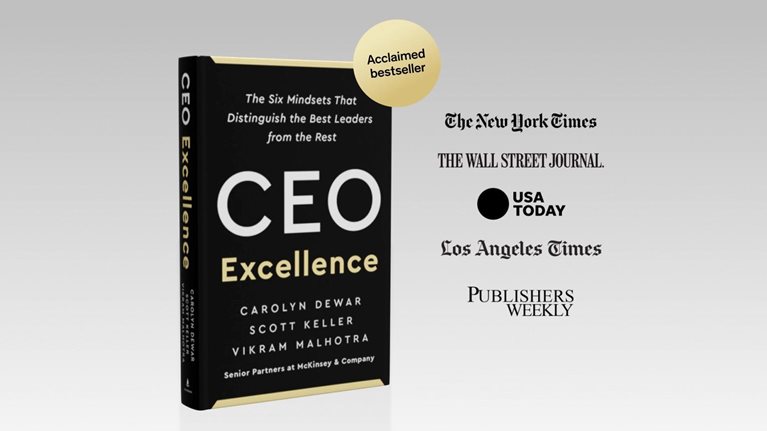
CEO Excellence

Deliberate Calm
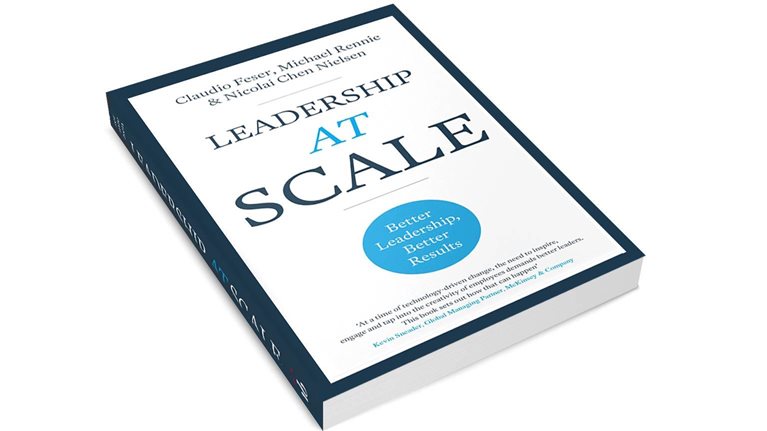
Leadership at Scale: Better Leadership, Better Results
Leading the c-suite.

Building Great CEOs

Author Talks: Indra Nooyi on leadership, life, and crafting a better future

Leading from the heart: How Freshworks’ CEO built a global tech unicorn

What resilience means to Nextdoor CEO Sarah Friar

Moderna’s path to vaccine innovation: A talk with CEO Stéphane Bancel
Welcoming Future Research Leaders to NIH
Posted on June 30th, 2021 by Dr. Francis Collins

Share this:
- Click to share on Facebook (Opens in new window)
- Click to share on Twitter (Opens in new window)
- Click to share on LinkedIn (Opens in new window)
- Click to share on Pinterest (Opens in new window)
- Click to share on Tumblr (Opens in new window)
- Click to share on Reddit (Opens in new window)
- Click to share on Telegram (Opens in new window)
- Click to share on WhatsApp (Opens in new window)
- Click to print (Opens in new window)
Posted In: Director's Album - Photos
Tags: 2021 Future Research Leaders Conference , diversity , IRP , Marie Bernard , NIH Intramural Research Program , Scientific Workforce Diversity , SWD
One Comment
Congratulations to my American emerging leaders in competitive timeline-driven biomedical research at NIH, USA!
Looking forward to future in-person visits………..
Propeling medical research is the primary scientific goal of meaningfully diminishing the disproportionate share of morbidity/mortality associated with life-threatening diseases in the current Covid-19 global pandemic era.
Leave a Comment Cancel reply
@nihdirector on twitter, nih on facebook.
Kendall Morgan, Ph.D.
Comments and Questions
If you have comments or questions not related to the current discussions, please direct them to Ask NIH .
You are encouraged to share your thoughts and ideas. Please review the NIH Comments Policy

- Visitor Information
- Privacy Notice
- Accessibility
- No Fear Act
- HHS Vulnerability Disclosure
- U.S. Department of Health and Human Services
- USA.gov – Government Made Easy
Discover more from NIH Director's Blog
Subscribe now to keep reading and get access to the full archive.
Type your email…
Continue reading
- SUGGESTED TOPICS
- The Magazine
- Newsletters
- Managing Yourself
- Managing Teams
- Work-life Balance
- The Big Idea
- Data & Visuals
- Reading Lists
- Case Selections
- HBR Learning
- Topic Feeds
- Account Settings
- Email Preferences
The Future of Leadership Development
- Mihnea Moldoveanu
- Das Narayandas

Companies spend heavily on executive education but often get a meager return on their investment. That’s because business schools and other traditional educators aren’t adept at teaching the soft skills vital for success today, people don’t always stay with the organizations that have paid for their training, and learners often can’t apply classroom lessons to their jobs. The way forward, say business professors Mihnea Moldoveanu and Das Narayandas, lies in the “personal learning cloud”—the fast-growing array of online courses, interactive platforms, and digital tools from both legacy providers and upstarts. The PLC is transforming leadership development by making it easy and affordable to get personalized, socialized, contextualized, and trackable learning experiences.
Gaps in traditional executive education are creating room for approaches that are more tailored and democratic.
Idea in Brief
The problem.
Traditional approaches to leadership development no longer meet the needs of organizations or individuals.
The Reasons
There are three: (1) Organizations, which pay for leadership development, don’t always benefit as much as individual learners do. (2) Providers aren’t developing the soft skills organizations need. (3) It’s often difficult to apply lessons learned in class to the real world.
The Solution
A growing assortment of online courses, social platforms, and learning tools from both traditional providers and upstarts is helping to close the gaps.
The need for leadership development has never been more urgent. Companies of all sorts realize that to survive in today’s volatile, uncertain, complex, and ambiguous environment, they need leadership skills and organizational capabilities different from those that helped them succeed in the past. There is also a growing recognition that leadership development should not be restricted to the few who are in or close to the C-suite. With the proliferation of collaborative problem-solving platforms and digital “adhocracies” that emphasize individual initiative, employees across the board are increasingly expected to make consequential decisions that align with corporate strategy and culture. It’s important, therefore, that they be equipped with the relevant technical, relational, and communication skills.
Whom do you know, and what can they teach you?
- MM Mihnea Moldoveanu is the Marcel Desautels Professor of Integrative Thinking, a professor of economic analysis, and director of the Desautels Centre for Integrative Thinking and of Rotman Digital at the Rotman School of Management at the University of Toronto.
- DN Das Narayandas is the Edsel Bryant Ford Professor of Business Administration at Harvard Business School.
Partner Center
- Data, AI, & Machine Learning
- Managing Technology
- Social Responsibility
- Workplace, Teams, & Culture
- AI & Machine Learning
Diversity & Inclusion
- Big ideas Research Projects
- Artificial Intelligence and Business Strategy
- Responsible AI
- Future of the Workforce
- Future of Leadership
- All Research Projects
- AI in Action
- Most Popular
- The Truth Behind the Nursing Crisis
- Work/23: The Big Shift
- Coaching for the Future-Forward Leader
- Measuring Culture

The spring 2024 issue’s special report looks at how to take advantage of market opportunities in the digital space, and provides advice on building culture and friendships at work; maximizing the benefits of LLMs, corporate venture capital initiatives, and innovation contests; and scaling automation and digital health platform.
- Past Issues
- Upcoming Events
- Video Archive
- Me, Myself, and AI
- Three Big Points

Big Idea Future of Leadership in the Digital Economy
In Collaboration With
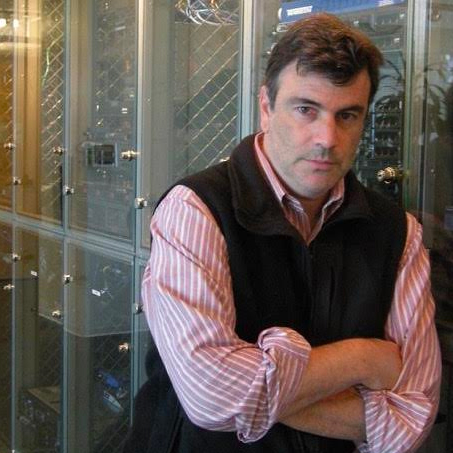
GUEST EDITOR
Michael schrage.
Research fellow, MIT Sloan Initiative on the Digital Economy
Since 2019, MIT Sloan Management Review and Cognizant have explored the implications digitalization has on leadership. In the recently released 2021 study, “Leadership’s Digital Transformation: Leading Purposefully in an Era of Context Collapse,” the authors expose a component of digital transformation that’s critical but often overlooked by leaders: themselves. The report offers actionable recommendations for leaders to more effectively lead their people and organizations in a time of blurred boundaries, rapidly shifting power dynamics, and general uncertainty.
The Future of Leadership 2021 Report
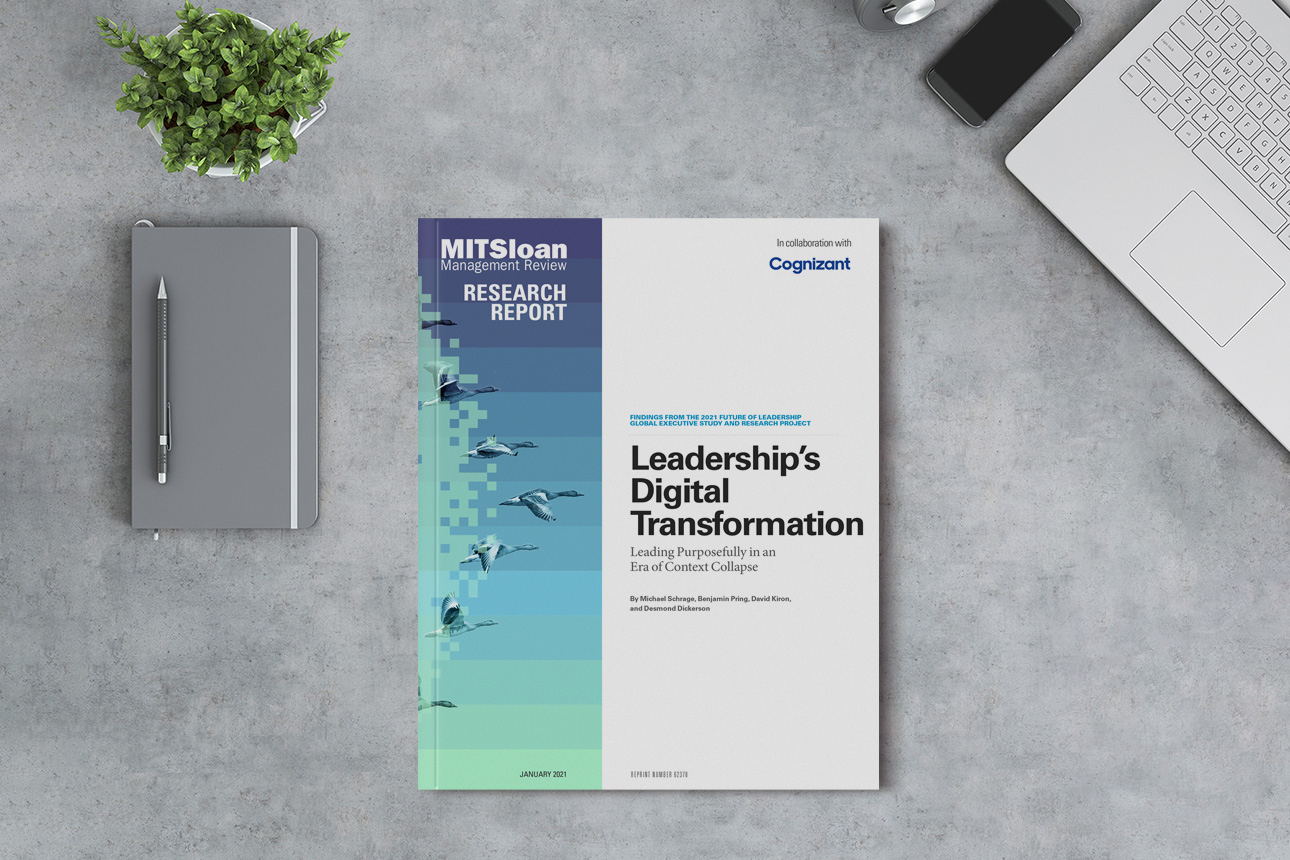
Leadership’s Digital Transformation
New research suggests that digital workforces expect digital transformation to better reflect and respect their concerns and values, not just boost business capabilities and opportunities. In the current environment, leaders must pay close attention to how their leadership is experienced, and consider whether digital tools, techniques, and technologies are making their companies’ key stakeholders — including employees, consumers, and investors — feel more valued.
Michael Schrage et al.

How Digital Transformation Disrupts Legacy Leaders
Michael Schrage and Benjamin Pring, coauthors of the 2021 research report, “Leaderhip’s Digital Transformation,” are joined by MIT SMR editor Allison Ryder to discuss key takeaways from the study.
The Future of Leadership 2020 Report

The New Leadership Playbook for the Digital Age
The 2020 Future of Leadership Global Executive Study and Research Report finds that leaders may be holding on to behaviors that might have worked once but now stymie the talents of their employees. Organizations must empower leaders to change their ways of working to succeed in a new digital economy.
Douglas A. Ready et al.
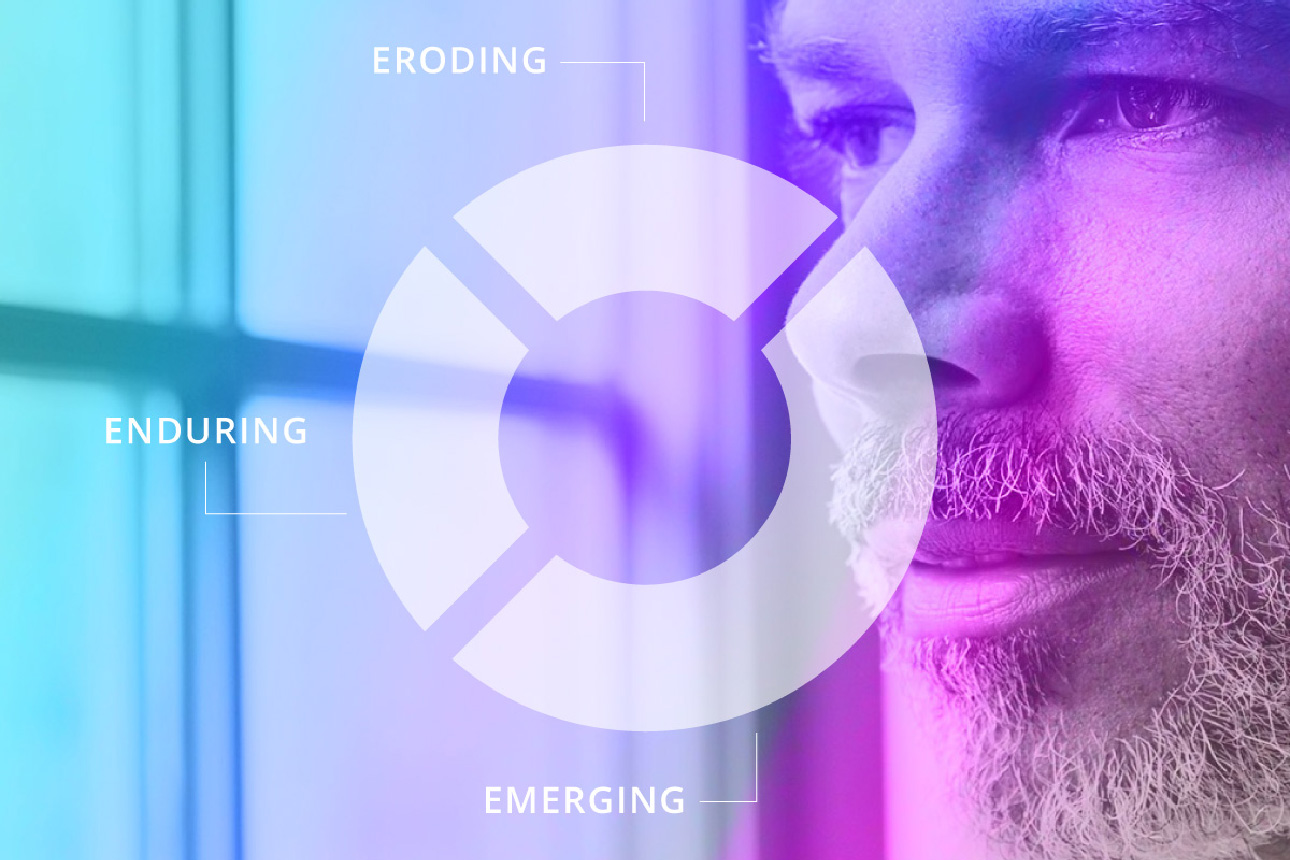
Interactive
A page from the new leadership playbook.
Leaders must modify their attitudes and beliefs about what leadership looks and feels like if they want to produce behavior change that lasts over time.

Reimagining What It Takes to Lead
The authors of the 2020 Future of Leadership report “The New Leadership Playbook for the Digital Age” discuss some of the findings from the research.
Insights on the Future of Leadership
Leadership skills, leadership mindsets for the new economy, douglas a. ready, the power of a clear leadership narrative, dodging digital blind spots, collaboration, why great leaders focus on mastering relationships, leading change, leading into the future, the enabling power of trust, leadership lessons from your inner child, closing the gender gap is good for business, douglas a. ready and carol cohen, in praise of the incurably curious leader.
Find your course
- Supporting our Researchers
Aston Future Research Leaders Programme
Aston University is delighted to announce the call for the second cohort of the Future Research Leaders Programme. In defining Research Leadership, we are making the distinction between the research responsibilities that all T&R and R-only colleagues should be routinely engaged with in relation to their own research and those who aspire to:
- set research and impact agendas within and beyond their core discipline,
- lead significant funding applications to develop strategically important research activity
- build collaborations with key academic and non-academic partners
- develop their own leadership and management skills,
- make significant contributions to the research culture at Aston and, more broadly, in the sector,
- lead and mentor others.
The programme consists of two elements; 1-2-1 coaching and group work in the form of Action Learning Sets.
- The coaching will consist of five confidential, one-to-one sessions (90 minutes each) with an experienced leadership coach. Coaching is designed to help participants identify, explore, and attend to the challenges they might encounter as a research leader at Aston. Coaches are there to facilitate thinking but not to give answers. They will create a space where participants can reflect on their roles, ambitions, leadership styles and relationships with other people.
- Action Learning is an approach to solving real problems that involves taking action and reflecting upon the results, therefore, helping to improve the problem-solving process. It requires a group of people (a set) who are supportive of one another to meet periodically to listen, ask questions, take action and provide feedback with the objective of individual and shared personal and professional growth. There will be five sessions, each lasting an hour.
The coaching will be delivered by an external provider with an excellent track record of working with many other UK universities for over a decade. Colleagues from Organisational Development will facilitate the Action Learning Sets.
September 2023: Welcome Lunch and Launch Event (2.5hrs)
Semester One and Two: Coaching Sessions x5 (90 mins)
Semester Three: Action Learning Sets x5 (1hr) The programme involves a significant commitment for participants; it is, therefore, advisable to discuss your application with your line manager before submission.
We are inviting applications from colleagues employed on a T&R or R-only contract who can demonstrate their desire to participate in this programme and how they think they would benefit from this investment in individual coaching. Applications will be accepted from colleagues at Senior Lecturer, Reader or Professorial level (Band 1 and promoted within the last two years only), and independent researchers .
We seek to be transparent, consistent, accountable and inclusive in how we run this selection process and encourage applications from all parts of our community. We recognise that career trajectories and individual profiles will also vary depending on the discipline and the extent to which research is basic/applied. It would not be surprising if an application from a newly promoted Professor in English looks different to that of a Senior Lecturer in Psychology, or an Engineer who is new to academia having moved from a senior role in industry or an applicant who currently holds a prestigious research fellowship. There is not a ‘perfect’ type of application that we are looking for.
We are committed to running an Equality Impact Assessment following the selection of candidates (which is why we will ask you for your staff ID when you apply) in addition, we ask about your ECR status as this is a self-identification and not routinely captured by HR.
I found it extremely helpful to take the time to reflect on my career progression, goals and to find the time to prioritise activities that will allow me to achieve my medium and long term targets. The discussions with the coach were a catalyst to identify strengths and areas of improvement.
2022/23 Participant
It has completely influenced my working in a very positive way. It has made me think about how I prioritise work, about what I want from my work and about the ways that I work (both positive and negative). It has been incredibly valuable for me.
I have really enjoyed the whole programme and we had some great sessions with my coach who walked me through a number of situations and problems and we devised a quantity of tools to deal with various elements of the academic work and related with it expectations and stress.
Key contacts: If you are interested in applying and have any questions, please contact either: Rebecca Stokes, Director of Research Strategy, Funding and Impact Your Associate Dean Research:
- Professor Nicholas O’Regan (BSS)
- Professor Patricia Thornley (EPS)
- Professor Roslyn Bill (HLS)
Your College Impact Lead:
- Dr Ed Turner (BSS)
- Professor Kate Sugden (EPS)
- Professor Afzal - Ur - Rahman Mohammed (HLS)
The deadline for applications is 16:00 (BST) September 1st 2023.
Application Form
Click here to apply to the Research Leadership Programme 2023/24
If you wish to complete an MS Word version of the form, please contact [email protected]
NIH Research Festival
September 13 – 15, 2017
- Future Research Leaders
FAES Terrace
The NIH Future Research Leaders Conference (FRLC), sponsored by the Chief Officer for Scientific Workforce Diversity (COSWD), is an event held in conjunction with the NIH Research Festival to promote knowledge and awareness about scientific career opportunities in the NIH Intramural Research Program (IRP).
The FRLC will provide early-stage investigators from the extramural and intramural community and from diverse backgrounds with an opportunity to:
- Learn about the various scientific opportunities and benefits of establishing a research career within the NIH IRP;
- Meet and interact with NIH investigators and scientific leadership through individualized meetings and scientific presentations;
- Create a network and establish mentoring relationships between FRLC participants and current intramural researchers.
The two and a half day program will include the following activities:
- Information sessions on scientific career opportunities at NIH IRP
- Scientific presentations by FRLC participants (oral & poster presentations)
- One-on-one meetings with NIH scientific leaders and investigators
- Networking sessions
- Opportunities to participate in the NIH Research Festival
- Career development session (e.g., NIH grants process)
- Facilities tours
Please contact [email protected] for any questions about the conference or visit their website .
This page was last updated on Monday, March 15, 2021
- General Schedule of Events
- Plenary Sessions
- Concurrent Symposia Sessions
- Poster Sessions
- FARE Award Ceremony
- Special Exhibits on Resources for Intramural Research
- Technical Sales Association (TSA) Research Festival Exhibit Tent Show
- Research Festival Committees
2017 program
Download the 2017 Research Festival Schedule Overview (6 pages)
CRCHD Announces the Establishment of Cancer Equity Leaders to Contribute to Health Equity Efforts, Host 2025 Event
April 8, 2024 , by CRCHD Staff
The NCI Center to Reduce Cancer Health Disparities is thrilled to announce the Cancer Equity Leaders (CEL), a diverse team of premier cancer research leaders who will reimagine and transform the future of cancer health equity. To achieve this aim, the group will work toward three objectives:
- Assess the landscape to elucidate critical strengths and gaps in cancer equity infrastructure.
- Prioritize the critical needs for expanding institutional capacity and achieving cancer health equity.
- Develop a strategic agenda to enhance the National Cancer Plan.
Through this work, the CEL will contribute to our understanding of cancer health equity and help CRCHD determine NCI’s diversity training, biomedical workforce development, and community outreach and engagement initiatives.
The CEL comprises 13 well-renowned and deeply respected cancer center and medical school leaders, with extensive expertise in the aforementioned areas and exceptional knowledge and understanding of all stages of the cancer continuum. See the full roster of this esteemed group below.
In 2025, the CEL team will host an event to hear and learn diverse perspectives across the cancer community to further advance NCI’s health equity efforts.
This initiative will be co-chaired by NCI CRCHD Director Sanya A. Springfield, Ph.D., and Karen Winkfield, M.D., Ph.D., Executive Director of the Meharry-Vanderbilt Alliance and Associate Director for Community Outreach & Engagement at the Vanderbilt-Ingram Cancer Center.
CEL Planning Committee Co-Chairs

Sanya A. Springfield, Ph.D. Director, Center to Reduce Cancer Health Disparities National Cancer Institute
Karen Winkfield, M.D., Ph.D. Executive Director Meharry-Vanderbilt Alliance Associate Director for Community Outreach & Engagement Ingram Professor of Cancer Research Vanderbilt-Ingram Cancer Center Professor of Radiation Oncology Vanderbilt University School of Medicine Professor of Global Health Meharry Medical College
CEL Members

John Carpten, Ph.D. Director, City of Hope Comprehensive Cancer Center Director, Beckman Research Institute of City of Hope Chief Scientific Officer Irell & Manella Cancer Center Director’s Distinguished Chair Morgan & Helen Chu Director’s Chair of the Beckman Research Institute City of Hope
Marcia Cruz-Correa, M.D., Ph.D. Professor of Medicine & Biochemistry, University of Puerto Rico Medical Sciences Campus Investigator, UPR Comprehensive Cancer Center
Chanita Hughes-Halbert, Ph.D. Vice Chair for Research and Professor, Department of Population and Public Health Sciences Dr. Arthur and Priscilla Ulene Chair in Women’s Cancer, Keck School of Medicine Associate Director for Cancer Equity, Norris Comprehensive Cancer Center University of Southern California
Juanita Merchant, M.D., Ph.D. Chief of Gastroenterology and Hepatology Regents Professor of Medicine Associate Director for Basic Science, UACC Interim Director, UA Comprehensive Cancer Center University of Arizona, Tucson
Ruben Mesa, M.D. President, Atrium Health Levine Cancer Executive Director, Atrium Health Wake Forest Baptist Comprehensive Cancer Center Enterprise Senior Vice President, Atrium Health Vice Dean for Cancer Programs, Wake Forest University School of Medicine The Charles L. Spurr MD Professor of Medicine, Wake Forest University School of Medicine
Valerie Montgomery Rice, M.D. President and Chief Executive Officer Morehouse School of Medicine
Kunle Odunsi, M.D., Ph.D. Director, University of Chicago Medicine Comprehensive Cancer Center Dean for Oncology, Biological Sciences Division The AbbVie Foundation Distinguished Service Professor Department of Obstetrics and Gynecology University of Chicago
Taofeek Owonikoko, M.D., Ph.D. Director, University of Maryland Greenebaum Comprehensive Cancer Center Marlene and Stewart Greenebaum Professor in Oncology, Department of Medicine Executive Director, UMSOM Program in Oncology Senior Associate Dean for Cancer Programs, University of Maryland School of Medicine Associate Vice President for Cancer Programs, University of Maryland, Baltimore
Ben Ho Park, M.D., Ph.D. Director, Vanderbilt-Ingram Cancer Center Benjamin F. Byrd, Jr. Chair in Oncology Professor of Medicine Division of Hematology/Oncology Vanderbilt University Medical Center
Yolanda Sanchez, Ph.D. The Maurice and Marguerite Liberman Distinguished Chair in Cancer Research Professor, Department of Internal Medicine Director & CEO, University of New Mexico Comprehensive Cancer Center
Selwyn Vickers, M.D. President and CEO, Memorial Sloan Kettering Cancer Center
Cheryl Willman, M.D. The Stephen and Barbara Slaggie Enterprise Executive Director, Mayo Clinic Cancer Programs Director, Mayo Clinic Comprehensive Cancer Center The David A. Ahlquist, M.D. Professorship in Cancer Research Professor and Consultant Department of Laboratory Medicine and Pathology Mayo Clinic College of Medicine & Science
Robert Winn, M.D. Director and Lipman Chair in Oncology, VCU Massey Comprehensive Cancer Center Senior Associate Dean for Cancer Innovation and Professor of Pulmonary Disease and Critical Care Medicine VCU School of Medicine
Featured Posts
April 8, 2024, by CRCHD Staff
February 15, 2024, by CRCHD Staff
February 6, 2024, by CRCHD Staff
Unethical Leadership: Review, Synthesis and Directions for Future Research
- Original Paper
- Open access
- Published: 18 March 2022
- Volume 183 , pages 511–550, ( 2023 )
Cite this article
You have full access to this open access article
- Sharfa Hassan ORCID: orcid.org/0000-0003-2828-4212 1 ,
- Puneet Kaur 2 , 3 ,
- Michael Muchiri ORCID: orcid.org/0000-0001-6816-8350 4 ,
- Chidiebere Ogbonnaya 5 &
- Amandeep Dhir 3 , 6 , 7
41k Accesses
24 Citations
70 Altmetric
Explore all metrics
The academic literature on unethical leadership is witnessing an upward trend, perhaps given the magnitude of unethical conduct in organisations, which is manifested in increasing corporate fraud and scandals in the contemporary business landscape. Despite a recent increase, scholarly interest in this area has, by and large, remained scant due to the proliferation of concepts that are often and mistakenly considered interchangeable. Nevertheless, scholarly investigation in this field of inquiry has picked up the pace, which warrants a critical appraisal of the extant research on unethical leadership. To this end, the current study systematically reviews the existing body of work on unethical leadership and offers a robust and multi-level understanding of the academic developments in this field. We organised the studies according to various themes focused on antecedents, outcomes and boundary conditions. In addition, we advance a multi-level conceptualisation of unethical leadership, which incorporates macro, meso and micro perspectives and, thus, provide a nuanced understanding of this phenomenon. The study also explicates critical knowledge gaps in the literature that could broaden the horizon of unethical leadership research. On the basis of these knowledge gaps, we develop potential research models that are well grounded in theory and capture the genesis of unethical leadership under our multi-level framework. Scholars and practitioners will find this study useful in understanding the occurrence, consequences and potential strategies to circumvent the negative effects of unethical leadership.
Similar content being viewed by others

Why Does Unethical Behavior in Organizations Occur?
Developing a framework for ethical leadership.
Alan Lawton & Iliana Páez

The Value of Autoethnography in Leadership Studies, and its Pitfalls
Jan Deckers
Avoid common mistakes on your manuscript.
Introduction
The contemporary business landscape is witnessing staggering levels of unethical conduct that has strikingly surfaced at the bottom-line figures with estimated total losses worth US$42 billion reported by PwC's Global Economic Crime and Fraud Survey ( 2020 ). Interestingly, the contributions of top management in various unethical practices account for over 26% which includes some of the costliest instances of fraud producing not only financial impacts for organisations but also emotional and psychological impacts for their stakeholders (PwC, 2020 ). While sufficient evidence also indicates that top management exhibits serious concerns for business integrity in terms of complying with rules and regulations, behaving responsibly towards various stakeholder groups and maintaining high moral standards (Earnest &Young, 2020 ), the trajectory of corporate scandals continues to increase at a more rapid rate than ever before (Mishra et al., 2021 ), and reciprocal dynamism is witnessed among ‘bad apples’ and ‘bad barrels’(Cialdini et al., 2021 ). Accordingly, corporate leaders, along with the cultures they foster within organisations, work in a vicious cycle wherein one reinforces the other to establish a breeding ground for profound and severe unethical practices. Unsurprisingly, therefore, more than 50% of companies globally experience a minimum of six fraud incidents per year, with another 50% not reporting or investigating the worst incidents (PwC, 2020 ). Hence, unethical leadership is at the intersection of immoral, illegal leadership practices and the unethical climate that further strengthens such leadership. Whether bad apples promote bad barrels or bad barrels host bad apples, the contemporary line of discourse in leadership is increasingly realising the consequential nature of unethical leadership.
Unethical leadership is conceptualised as leader behaviours and decisions that are not only anti-moral but most often illegal and exhibit an outrageous intent to instigate unethical behaviours among followers (Brown & Mitchell, 2010 ). Unethical leadership has long been documented to cause a deleterious impact on organisations. For example, the famous emissions scandal of Volkswagen, known as ‘Dieselgate’, cost the company an estimated US$63 billion (Jung & Sharon, 2019 ). The consequences of this scandal resulted from an interplay of unethical leaders and an unethical organisational culture (Javaid et al., 2020 ). Similar evidence has been reported in another famous case involving Enron, where an unethical climate fostered conscious rule breaking within the organisation, which resulted in both reputational and financial consequences (Sims & Brinkmann, 2003 ). This scenario has been accentuated by the growing reporting of corporate misconduct in the mainstream media (Chen, 2010a ), which has heightened the interest of scholars in this direction.
Research into unethical leadership has largely focused on the aftermath that accompanies organisation leaders’ morally inappropriate and legally unacceptable behaviours that are directed towards the organisation and followers (Javaid et al., 2020 ). Scholars have gauged the impact of unethical leadership in the domains of employee attitudes, e.g. intentions to stay (Ruiz-Palomino et al., 2021 ) and intentions to engage in fraudulent acts (Johnson et al., 2017 ), and employee behaviours, e.g. counterproductive work behaviours (Knoll et al., 2017 ), crimes of obedience (Carsten & Uhl-Bien, 2013 ) and knowledge hiding (Qin et al., 2021 ), among others. Recently, scholars have begun to investigate the team- or group-level ( b ; Cialdini et al., 2021 ; Peng, Schaubroeck, et al., 2019 ) and organisational-level consequences (Mujkic & Klingner, 2019 ; Sherif et al., 2016 ; Vasconcelos, 2015 ) of this phenomenon; however, such investigations remain scant.
An important trend in recent years is the interchangeable use of various measures, conceptualisations and terminologies, which has, by and large, confused the research space on unethical leadership. In fact, concepts such as destructive leadership and its offshoot abusive supervision have dominated this area (Mackey et al., 2021 ), and research pertaining solely to unethical leadership has received extremely limited attention. Given the rampant proliferation of measures and concepts, both the empirical and conceptual distinctiveness of unethical leadership has been blurred (Ünal et al., 2012 ). Furthermore, a dispute over the distinction between unethical and ethical leadership has distorted the conceptual underpinnings of both concepts. Some scholars treat unethical leadership as the flipside of ethical leadership and equate the absence of exemplary leader behaviours with the presence of unethical leadership. However, others have challenged this notion, asserting a quantitative distinction between unethical and ethical leadership styles, which requires separate lines of academic inquiry (Gan et al., 2019 ). Ünal et al. ( 2012 ) captured this view, demonstrating that a single occurrence of dysfunctional leader behaviour does not amount to unethical leadership.
Despite the consequential and distinctive nature of unethical leadership, scholars have made few attempts to systematically organise the literary work in this field and thereby facilitate a comprehensive understanding of unethical leadership from an academic perspective. One of the earliest scholarly investigations in this regard is that of Brown and Mitchell ( 2010 ), who synthesised the academic literature on unethical leadership under the framework of ethical leadership. Their article had an overt focus on ethical leadership within organisations, which they supplemented with unethical perspectives on leadership to broaden the study’s scope. Our review is not only exclusively geared towards unethical leadership but also distinguishes unethical leadership from the absence of ethical behaviours. Furthermore, the early work on unethical leadership does not provide a comprehensive account of the developments in the area, perhaps because this line of literature, as a separate research area, has developed only in the recent past. Thus, we believe that the significant body of research conducted on unethical leadership since Brown and Mitchell’s ( 2010 ) review study needs to be synthesised. Furthermore, Lašáková and Remišová ( 2015 ) enhanced theoretical understanding of unethical leadership by delineating problems in its existing conceptualisations. While their study broadened the concept’s definitional space, it did not account for the extant empirical work in the area. Our study not only distinguishes unethical leadership from related concepts but also provides a detailed view of the empirical work in the area and offers new practical insights into the field.
Apart from the above-discussed rationale, we contend that unethical leadership remains the least researched concept among its academic offshoots. In fact, scholars have thoroughly investigated concepts such as abusive supervision and destructive leadership via both empirical studies and a good number of systematic literature reviews (SLRs) and meta-analyses (Mackey et al., 2017 , 2021 ; Schyns & Schilling, 2013 ; Zhang & Bednall, 2016 ). This points towards the need to examine the extant unethical leadership studies in their own right without confusing them with studies that focus on any of these related concepts. Furthermore, existing SLRs are either too specific or too general and, thus, provide few insights into the area of unethical leadership. For example, studies pertaining exclusively to abusive supervision highlight the verbal and non-verbal abuse leaders direct towards their followers, but these studies offer only a limited understanding of other unethical behaviours, e.g. violations of rules or norms. In the same manner, studies pertaining to destructive leadership examine myriad behaviours that further add to the problematic proliferation of concepts in this research domain (Mackey et al., 2021 ).This underscores an urgent need to re-examine the concept of unethical leadership and the associated literature and thereby facilitate a robust understanding of unethical leadership as a distinct concept.
The current study’s overarching aim is, thus, to conduct an SLR of the extant literature and thereby not only help to synthesise this literature but also identify new issues and broaden the horizon of research in that area by highlighting important knowledge gaps in the existing body of work. Consistent with the above discussion, the present study seeks to address the following research questions (RQs): RQ1 What is the research profile of the relevant extant literature published on unethical leadership? RQ2 What are the dominant focus areas and themes on which most of the academic inquiry has concentrated? RQ3 What are the important knowledge gaps in the existing body of research and potential future research areas that must be investigated to enrich the field?
To address the above research queries, we first extracted the most relevant data with the aid of a robust SLR protocol that has already been validated in a number of studies (Kaur et al., 2021 ; Khan et al., 2021 ; Seth et al., 2020 ; Talwar et al., 2020 ). For RQ1 , we generated the descriptive statistics for the existing research by establishing precise inclusion and exclusion criteria and listing the keywords to search in the most reliable databases. To address RQ2 , we organised all of the shortlisted studies around themes derived from the results of our content analysis. For RQ3 , we identified research gaps and corresponding research questions specific to each emergent theme. To further complement the identified gaps, we developed a multi-level framework of unethical leadership—titled the ‘M3 framework’. Furthermore, we proposed seven potential research models for scholars and practitioners interested in studying unethical leadership. The proposed framework and potential models will be useful for delineating the specific variable relationships scholars can examine in greater detail and from various theoretical lenses to facilitate both conceptual and empirical work in this area. Therefore, these models aim to capture some of the lacunae in the literature.
This SLR is organised into the following sections. In Sect. 2, we examine the conceptual understanding of unethical leadership and make some important distinctions between unethical leadership and other concepts. Section 3, which is devoted to the methodology, explicates the exact protocol we followed to identify the relevant corpus of studies. In this section, we discuss both the data extraction process and the research profile of the sampled studies. In Sect. 4, we discuss the themes that emerged in the coding process as well as the knowledge gaps and potential research questions pertaining to each theme. In Sect. 5, we propose and discuss the conceptual framework and seven potential research models based on gaps identified in Sect. 4. Section 6 provides the practical and theoretical implications of the current study, while Sect. 7 concludes the study by acknowledging its limitations.
Conceptualising Unethical Leadership
Defining unethical leadership.
Contemporary discourse on unethical leadership remains relatively sparse, with only a few studies extensively focused on crystallising the conceptual underpinnings of this leadership type. Brown and Mitchell ( 2010 ) laid the early foundations by offering definitional and conceptual reflections on the phenomenon. They defined unethical leadership ‘ as behaviours conducted and decisions made by organisational leaders that are illegal and/or violate moral standards and those that impose processes and structures that promote unethical conduct by followers ’ (Brown & Mitchell, 2010 , p. 588). The essential tenet of this definition pertains to the leader behaviours that instil unethical conduct in followers. Under this definition, therefore, unethical leadership amounts not only to leaders themselves engaging in unethical behaviours but also enabling and harnessing unethical follower behaviours. Leaders perform these efforts either by overtly demonstrating unethical conduct or passively promoting an unethical climate by ignoring unethical conduct and, thus, allowing unethical behaviours to flourish within organisations (Brown et al., 2005 ).The potential drawback of this definition, however, is its failure to explicitly identify the exact behaviours that could be labelled as unethical. Because morality is a diverse and culturally ingrained phenomenon, the manifestations of unethical behaviours are likewise diverse, which renders unethical leadership a rather relative concept (Resick et al., 2011 ).
To address some of these pitfalls, Ünal et al., ( 2012 ) conducted a seminal study to develop a more robust and comprehensive understanding of unethical leadership. They discussed unethical leadership from normative perspectives and advanced a deeper understanding of the concept by differentiating it from similar leadership styles as well as from the lack of exemplary ethical leader behaviours. Specifically, they defined unethical leadership/supervision as ‘ supervisory behaviours that violate normative standards ’(Ünal et al., 2012 , p.6). Their distinction between unethical leadership and other related concepts, along with the description of precise unethical leadership practices, offers nuanced insights into this research area. In particular, they utilised virtue ethics, deontology, teleology and utilitarian perspectives to develop normative foundations of unethical leadership practices. They identified the violation of employee rights, unfair justice mechanisms, violation of legitimate organisational interests and weak leader character as potential manifestations of unethical leadership. Subsequent research has captured these manifestations of unethical leader behaviour in various cultural contexts. For example, Eisenbeiß and Brodbeck ( 2014 ) examined cross-cultural and cross-sectoral similarities in unethical leadership perceptions. Their comparative research highlighted the interplay of compliance-oriented and value-oriented perspectives within the domain of unethical leadership, and they identified dishonesty, unfair treatment, irresponsible behaviour, non-adherence to rules, laws and regulations, engagement in corruption and other criminal behaviours, an egocentric orientation, manipulative tendencies and a lack of empathy towards followers as the common manifestations of unethical behaviour in various countries.
The above discussion highlights the efforts made, thus, far to clarify what unethical leadership is and what it is not and to define it as a distinct concept rather than merely the opposite of ethical leadership (Ünal et al., 2012 ). With research on unethical leadership taking a new direction and scholars investigating distinct yet related concepts more frequently than unethical leadership itself, however, it becomes crucial to highlight unethical leadership as a separate line of inquiry that requires equal attention. In the sections that follow, we discuss some of these concepts and reveal the differences between them and the concept of unethical leadership.
Unethical Leadership and Related Concepts
The domain of unethical leadership has witnessed an increasing proliferation of concepts, which has seriously obstructed the meaningful application of findings to unethical leadership research and practice (Tepper & Henle, 2011 ; Ünal et al., 2012 ). For example, scholars have employed concepts including petty tyranny (Ashforth, 1997 ), supervisor undermining (Duffy et al., 2002 ), workplace aggression (Neuman & Baron, 1998 ), despotic leadership (De Hoogh & Den Hartog, 2008 ), abusive supervision (Tepper, 2000 ), destructive leadership (Einarsen et al., 2007 ) and some newer forms, e.g. Machiavellian leadership (Belschak et al., 2018 ), interchangeably. In fact, concepts such as abusive supervision and destructive leadership have received the most scholarly attention and have developed into separate lines of academic inquiry. It is important to mention here that destructive leadership and abusive supervision have been highly influential in the academic literature (Mackey et al., 2021 ), and the remainder of the concepts mentioned above fall under the domain of these two leadership types. Hence, we discuss these two concepts and attempt to differentiate them from unethical leadership. Furthermore, we advance the conceptual distinction between unethical leadership and the absence of ethical leadership/the lack of exemplary ethical behaviours. Figure 1 presents a conceptual overview of the differences between unethical leadership and other forms of leadership styles. Before discussing these, we provide a brief conceptual understanding of unethical leadership and the lack of ethical behaviours.

Overview of conceptual differences between unethical leadership and other forms of leadership styles
Unethical Leadership vs Lack of Ethical Leadership
The dominant discussions on ethical and unethical leadership have recently shifted towards viewing ethical and unethical leadership as distinct concepts that require their own investigation (Gan et al., 2019 ). These concepts are increasingly recognised as quantitatively distinct, with scholars acknowledging that the absence of ethical behaviour does not necessarily amount to unethical leadership (Ünal et al., 2012 ). While ethical leadership is ‘ the demonstration of normatively appropriate conduct through personal actions and interpersonal relationships’ (Brown et al., 2005 , p. 120), unethical leadership, as discussed above, incorporates behaviours and decisions that could be illegal or morally unsound (Brown & Mitchell, 2010 ). This suggests that the mechanism that explains the formation of unethical leadership and its consequences is distinct from that of ethical leadership (Gan et al., 2019 ). Therefore, a single instance of dysfunctional leader behaviour does not always equate to unethical leadership (Ünal et al., 2012 ). This understanding has implications for the concept’s operationalisation because simply reverse coding the scale items would fail to accurately reflect an unethical leader’s behaviour. Hence, the present study incorporates research that has explicitly studied unethical leadership. In mining the literature, we specifically sought studies that were focused on unethical leadership and not those where the major theme was the absence of exemplary leader behaviours or ethical failures.
Unethical Leadership vs Destructive Leadership
Destructive leadership is defined as ‘ a process in which over a longer period of time the activities, experiences and/or relationships of an individual or the members of a group are repeatedly influenced by their supervisor in a way that is perceived as hostile and/or obstructive ’ (Schyns & Schilling, 2013 , p. 141) While an overlap appears to exist between unethical and destructive leadership, a fine line separates these concepts. Destructive leadership essentially captures harmful methods of influence directed at followers (Mackey et al., 2021 ), and it includes myriad leader behaviours, such as punishment, leader incivility, leader undermining, leader atrocities, toxic behaviours etc. We argue that although both concepts share the dimension of immorality, unethical leadership also includes behaviours that can be compliance based (Eisenbeiß & Brodbeck, 2014 ). In other words, unethical leadership can also entail behaviours that are illegal and amount to regulatory violations (Javaid et al., 2020 ). Furthermore, we argue that some types of destructive leader behaviours—e.g. tyrannical and insular leadership—can be pro-organisational. While such leadership types override follower interests, leaders pursue them under the guise of organisational interests (Einarsen et al., 2007 ).
In fact, pseudo-transformational leadership, yet another form of destructive leadership, has the potential to yield positive organisational outcomes (Almeida et al., 2021 ). In contrast, unethical leadership includes behaviours that are undeniably illegal and, at the same time, violate moral standards, thus, granting no benefit of the doubt to the intentionality of the leader’s behaviour. It can, thus, be inferred that destructive leadership and its various types employ ‘harmful methods of follower influence’, where the intentionality of such behaviour is subject to interpretation. While unethical leadership may not employ harmful methods of punishment, oppression or committing atrocities, it may reflect in corporate scandals and financial misreporting, among others. Finally, destructive leadership, which essentially includes behaviours that are hostile and obstructive, can originate from other types of leadership that need not be unethical. Even positive leadership types, e.g. ethical leadership, can instigate hostile behaviours with the presence of a curvilinear relationship between ethical leadership and positive employee outcomes (Stouten et al., 2013 ).
Unethical Leadership vs Abusive Supervision
Another leading concept in this direction is abusive supervision, which scholars have, at times, categorised under destructive leadership. Abusive supervision is defined as ‘subordinates' perceptions of the extent to which supervisors engage in the sustained display of hostile verbal and nonverbal behaviours, excluding physical contact ’ (Tepper, 2000 , p. 178). Under this definition, abusive supervision, like destructive leadership, encompasses longitudinal hostile behaviours, but these are limited solely to verbal and non-verbal abuse (i.e. these behaviours exclude physical abuse; Zhang & Bednall, 2016 ). Once again, however, scholars have not explicated the direction of outcomes in the context of abusive supervision, making it a typical category of destructive leadership (Guo et al., 2020 ).
The target of the intended behaviour is another critical point of distinction not only for delineating the scope but also the research framework of the present study. Under abusive supervision, leaders’ demeaning language and derogatory remarks are directed solely at their followers (Tepper, 2000 ). Under unethical leadership, however, different forms of unethical leader behaviours can target both followers and organisations. This confirms the view that abusive supervision is highly psychological in nature, encompassing high-intensity hostile behaviours that are directed at people (Almeida et al., 2021 ). The preceding discussion, however, suggests that unethical leadership need not be highly intense or hostile. Rather, it can entail passive and more subtle as well as legally unacceptable behaviours. This means that unethical leadership, unlike abusive supervision, can be task-oriented. Therefore, corporate scandals and financial misreporting fall under the concept of unethical leadership, and abusive supervision is, thus, conceptually distinct from unethical leadership. Furthermore, abusive supervision entails micro-level interactions between a leader and his or her immediate followers. In contrast, unethical leadership can operate at many levels and is much broader than these interactions between the leader and his or her followers.
The remaining concepts enumerated above, including petty tyranny, supervisor undermining, workplace aggression, despotic leadership, corrupt leadership, evil leadership and derailed leadership, likewise fall under the framework of destructive leadership with minor differences based on intentionality, types of behaviour, perceived versus actual behaviour, the inclusion of outcomes and the persistence of behaviours (Schyns & Schilling, 2013 ; Ünal et al., 2012 ). For example, workplace aggression is a type of destructive leadership wherein leaders direct hostile physical behaviours—e.g. pushing, hitting etc.—towards their followers (Neuman & Baron, 1998 ). Similarly, individuals who exercise Machiavellian leadership do not exhibit persistent hostile behaviours but rather intermittent and situational hostile behaviours towards followers (Belschak et al., 2018 ). It is important to mention here that although these conceptual differences have been delineated, the operational measurement of these concepts is not mutually exclusive, which often renders them interchangeable (Ünal et al., 2012 ). However, the current study treats them as separate concepts and includes only those studies that have examined unethical leadership in its own right without reference to any of these overlapping concepts.
The aim of the present study is to systematically review the extant literature on unethical leadership. Systematic reviews are considered scientific and enable the researcher to identify and critically analyse relevant research in a particular domain. This method of synthesising academic literature has gained acceptance across various disciplines primarily because it enhances research rigour (Dorn et al., 2016 ). In fact, the SLR method has gained wider acceptance in the management literature (Talwar et al., 2020 ) because it provides evidence-informed and reproducible research (Tranfield et al., 2003 ). As we discuss in the following paragraphs, SLRs ensure an audit trail of the decisions taken, which produces transparent, unbiased and objective results with minimum bias (Seth et al., 2020 ).
To ensure objectivity throughout the entire process, researchers follow various steps in systematically synthesising the existing body of research in a particular domain; the resulting objectivity in the process, in turn, expands opportunities for replicating as well as extending the work of the SLR (Seth et al., 2020 ; Talwar et al., 2020 ). Consistent with the procedures previous scholars have followed, we employed a four-step sequential process to systematically review research in the area of unethical leadership. We began by planning the review and ended with a descriptive analysis of the sampled studies. We now discuss these steps in detail (see Fig. 2 ).
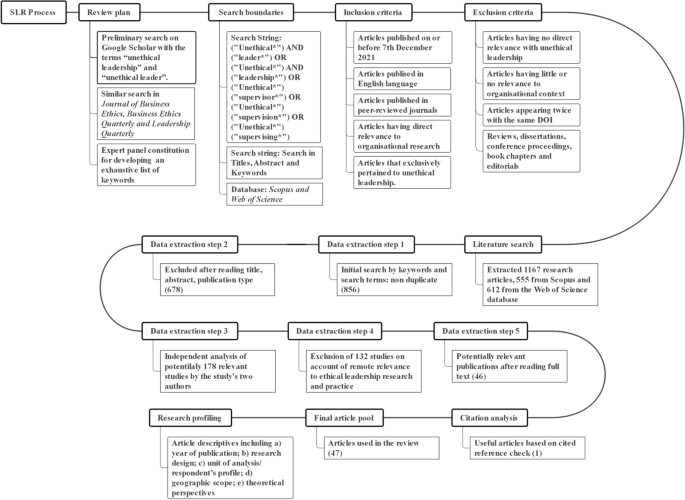
An overview of the SLR process

Planning the Review
In this step, which aims to obtain the most relevant and greatest number of results, we ran a preliminary search on Google Scholar with the terms ‘unethical leadership’ and ‘unethical leader’. We analysed the first 100 results from this initial search to update the list of keywords that would eventually be used in developing the final corpus of studies. Then, consistent with best practices, we ran a similar search in the leading journals on ethics, including the Journal of Business Ethics , Business Ethics Quarterly and Leadership Quarterly , to ensure that we did not miss any important studies. Recent work in the domain of business ethics has supported the inclusion of these journals (Newman et al., 2020 ). The results from Google Scholar and reputed journals in business and ethics revealed that, by and large, the literature has employed uniform terminology for unethical leadership with a difference of one or two concepts, e.g. unethical supervision and bad leadership. Therefore, to ensure that we used only the most relevant search terms, we constructed a review panel, which consisted of two senior professors and two senior scholars. The panel was assembled with the intent to provide us with critical feedback and appraisal before we finalised each step in the process. After thorough discussions with the panel members, we added ‘unethical supervision’, ‘unethical supervising’ and ‘unethical supervisor’ to the initial list of keywords. Finally, we searched these terms in Scopus and Web of Science databases because these databases have been frequently used in SLRs due to the exhaustive list of journals they host, particularly in social sciences research (Mongeon & Paul-Hus, 2016 ).
Screening Criteria
We established the following inclusion criteria before constructing the dataset for the present study. First, we only included studies that were peer-reviewed and published in the English language on or before 7 December 2021. Second, we included studies that contained the term unethical leadership in any part of the study, including the title, abstract, keywords or text. Third, we only included studies that had direct relevance to organisational research. Fourth, we only included studies that pertained to unethical leadership. In other words, we discarded studies that used synonyms for unethical leadership that are conceptually different from unethical leadership unless otherwise specified. The exclusion criteria caused us to omit those studies that(a) had no direct relevance to unethical leadership; (b) had little or no relevance to the organisational context—e.g. teacher samples, military samples, sports administration; (c) appeared twice with the same DOI and (d) pertained to reviews, dissertations, conference proceedings, book chapters and editorials.
Data Extraction
We used asterisk (*), 'OR' and 'AND' connectors to develop search strings for use in the databases. We retrieved a total of 1167 research articles, 555 from Scopus and 612 from the Web of Science databases. We removed duplicate items, which reduced the initial corpus to 856. These remaining studies were filtered through the inclusion and exclusion criteria, which resulted in the exclusion of 678 studies. It is important to mention here that studies pertaining to abusive supervision, destructive leadership and authentic supervision were excluded for the reasons mentioned in Sect. 2. The two authors then thoroughly and independently analysed the remaining 178 studies. After a comprehensive evaluation of these studies, we decided that another 132 studies should be removed because they were only remotely relevant to ethical leadership research and practice. For example, initially, we had shortlisted pseudo-transformational leadership (Barling et al., 2008 ) as a type of unethical leadership, but after carefully screening the text, we decided that this type of leadership does not directly pertain to the research domain of unethical leadership. This left us with 46studiesin the main dataset of the present study. Finally, we added one paper manually after conducting forward and backward chaining of the references of the 46 shortlisted papers (see Fig. 2 ). Because two authors were independently involved in this process, we assessed interrater reliability (IRR) using the kappa statistic (Landis & Koch, 1977 ), which significantly exceeded the threshold for agreement between the independent coders.
Research Profiling
A comprehensive overview of the extant literature on unethical leadership is presented in Table 1 .This includes (a) year of publication; (b) research design; (c) unit of analysis/respondent profile; (d) geographic scope and (e) theoretical perspectives. The table reveals that research on unethical leadership has progressed, particularly over the past three years. However, much of the research remains concentrated in developed nations, particularly the USA, which poses serious limitations to the generalizability of the results to emerging nations. Most scholars have employed quantitative techniques, including field surveys, laboratory experiments and field experiments, and various quantitative techniques, including structural equation modelling, logistic regression, hierarchical regression and polynomial regression, to enhance the existing understanding and the generalizability of the results. Interestingly, a good number of scholars have utilised multiple surveys in the same study to comprehensively gauge the proposed effects. For example, scholars have often used experiments and questionnaire-based surveys with different respondents in a single study to enhance the reliability and generalizability of their findings.
No consensus exists regarding the best type of scale for capturing unethical leader behaviours. We observed the use of various scales, with some of the studies simply reverse coding the ethical leadership scale items. For example, Cialdini et al. ( 2021 ) reverse coded the scale item, ‘ Sets an example of how to do things the right way in terms of ethics ’, so that a higher score represented unethical behaviour. The remainder of the studies employed toxic leadership dimensions (Ruiz-Palomino et al., 2021 ) or organisational and interpersonal deviance (Qin et al., 2021 ), or they adapted general unethical organisational behaviours to the leadership context (Fehr et al., 2020 ; Javaid et al., 2020 ).
Moral theory, institutional theory, social cognitive theory and social information processing theory have been the most widely used approaches to understand the phenomenon of unethical leadership in organisational contexts. However, we also observed that scholars have relied less on validation from other theoretical perspectives, e.g. institutional pillars, organisational structure, goal setting and stakeholder theory, among myriad others.
Finally, most of the studies have used organisations, managers, CEOs and employees as the main respondents from whom to collect data—mostly through questionnaires administered via various offline and online modes. While these categories of respondents are common in leadership research, few studies have examined leader–follower dyads.
Review of Extant Research on Unethical Leadership
We thoroughly analysed the final sample of included studies with the goal of understanding the antecedents, boundary conditions and consequences of unethical leadership. We employed the content analysis method, a qualitative data analysis technique, to analyse and synthesise the selected studies and thereby develop themes, identify critical knowledge gaps in the existing literature and suggest future research directions. We adopted a three-step protocol employed in recently published studies (Kaur et al., 2021 ; Khan et al., 2021 ; Seth et al., 2020 ), which minimises bias and produces an audit trail of crucial decisions in conducting SLRs. Following Glaser and Strauss ( 1967 ), we developed first-order codes and second-order codes and, finally, segregated the studies into aggregate theoretical dimensions (see Fig. 3 ). In the first step, we utilised open coding to categorise all of the reviewed studies into provisional categories. We then examined the studies to determine their research model and the results of the relationships hypothesised. When this was not possible, we relied on the major findings of the study to curate themes. In the next step—i.e. the axial coding process, we examined the relationships among these categories following deductive and inductive logic to arrive at broader categories. In the final step, we used the selective coding process to identify the final core/aggregate thematic dimensions, which we will discuss in the subsequent sections. In this step, we also invited two academicians with experience in ethics-related topics to review the aggregate themes developed in the prior step. Upon receiving their feedback, we made some minor changes to the themes.
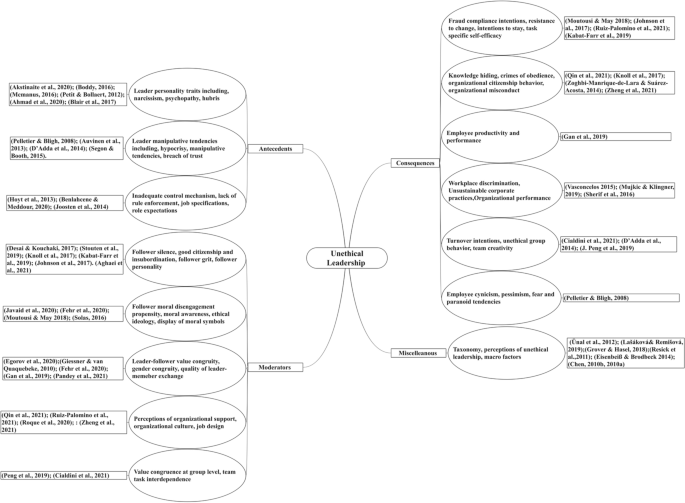
Concept map of extant research on unethical leadership
The process resulted in four broad themes: antecedents, consequences, boundary conditions and miscellaneous. The first three themes are discussed at three levels: the individual, group and organisational levels. Figure 4 presents an overview of the three key thematic areas of research examined in the prior extended literature. The major scholarly work has expanded to gauge the impact of unethical leadership, with employee-related outcomes receiving the greatest attention. We also noted that group-level examinations of unethical leadership are quite scant with outright exclusion of group-level antecedents. In the following sections, we discuss these levels and the associated factors in detail and propose important research directions in the area.
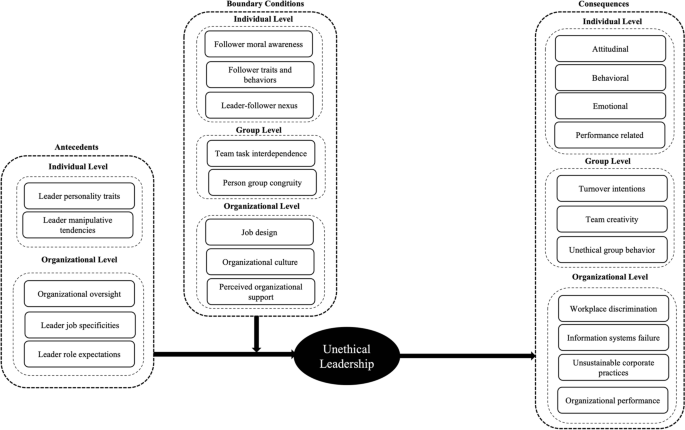
An overview of associations among three key thematic areas of research on unethical leadership
Antecedents of Unethical Leadership
We discuss factors that lead to the formation of unethical leadership and identify possible knowledge gaps in this direction.
Individual-Level Antecedents
Leaders’ personality traits.
In seeking to identify individual-level factors that promote unethical leader behaviours, the prior literature has devoted significant attention to leaders’ personality traits. In particular, the literature has cited narcissism, hubris and psychopathological traits as the determinants of unethical leader behaviour. Scholars suggest that a narcissistic leader is likely to possess inflated views about his or her own achievements and capabilities, which create dysfunctional agentic relationships among leaders and followers because leaders promote their own self-interests at the expense of their followers (Campbell et al., 2011 ). Narcissistic leaders indulge in self-aggrandising and derogatory behaviours, which often causes their subordinates to perceive them as unethical in the context of organisations (Hoffman et al., 2013 ). In addition, leaders who are high in narcissism can exhibit moral entitlement, where follower pro-organisational behaviour could lead to the emergence of unethical leadership (Ahmad et al., 2020 ).
Hubris is a similar personality trait that refers to a leader’s exaggerated confidence and prestige in work-related situations. Hubris is often described as a cognitive state in which leaders develop an amplified sense of self-esteem and pride in their abilities; their inflated self-esteem and pride, in turn, makes them think that prevailing norms do not apply to them, which could result in unethical manifestations of this personality trait (Petit & Bollaert, 2012 ). Research has provided similar evidence regarding hubris among CEOs. CEO hubris has a significant influence on the unethical practice of earnings manipulation in organisations (McManus, 2016 ). In fact, hubris is positioned to stimulate leaders towards manipulative language use, which could foster an unethical climate within organisations (Akstinaite et al., 2020 ).
Finally, unethical leadership practices are also associated with psychopaths who are deficient in emotions and conscience and, thus, engage in cold, ruthless and self-seeking behaviours (Marshall et al., 2014 ). Boddy’s ( 2016 ) study supported this, finding that leader psychopathy is associated with unethical practices, including corporate scandals.
The above discussion signals that the literature, thus, far has examined only dark personality traits, which opens room for other personality frameworks in this direction. The two key research gaps in this regard are as follows. First, many individual factors, needs and behaviours remain unexamined in the literature, thus, far. Second, different personality frameworks have not been validated in the context of unethical leadership. We propose three research questions to address these research gaps. RQ1 How do leaders’ various needs (e.g. achievement, power, affiliation) produce unethical behaviours? RQ2 Do leaders’ personality traits adjust in the work context to stimulate unethical practices? RQ3 Can the cybernetic Big Five model be used to explain unethical leadership?
Leaders ‘Manipulative Tendencies
Leader immorality has long been considered the foundational pillar of unethical leadership practices within organisations (Hartman, 2000 ; Pelletier & Bligh, 2008 ). Unethical leaders are often associated with a lack of integrity and exhibit manipulative behaviours, including hypocrisy and breach of trust (Pelletier & Bligh, 2008 ). Here manipulation refers to the deliberate unethical use of leader competencies and use of manipulative communication directed towards followers in a disguised way (Auvinen et al., 2013 ). Scholars have identified leaders’ prominent statements and communication styles as fostering unethical behaviour within organisations (Akstinaite et al., 2020 ; D’Adda et al., 2014 ). Such manipulative storytelling directed towards followers is considered one possible way to fortify unethical leadership practices within organisations (Auvinen et al., 2013 ). In fact, such manipulation is also manifested in leaders’ use of their emotional competencies to serve their self-interests (Segon & Booth, 2015 ).
While immoral behaviour is the cornerstone of most negative leadership types, including unethical leadership, scholars have investigated most manipulative tendencies in isolation without any regard to leader–follower interactions or person–situation perspectives. To address this gap, we propose the following RQs. RQ1 How can a leader's expression of humour and/or anger interact with his or her moral awareness to produce unethical behaviours? RQ2 What is the relationship of leaders’ implicit personality traits (incremental and entity) and leader–situation fit on the formation of unethical leadership?
Organisational-Level Antecedents
Despite the centrality of organisational factors in the formation of unethical leadership, scholarly attention in this direction is quite scarce. One of the important organisational-level factors with the potential to facilitate unethical behaviour is the lack of organisational oversight mechanisms. When organisations have inadequate control mechanisms, lackadaisical rules enforcement and a lack of transparency, unethical leader behaviours tend to surface (Benlahcene & Meddour, 2020 ). The job specificities and role expectations that are entrusted to a leader can accentuate this effect. For example, under the framework of social role theory, the overarching importance of group goals and the expectations thereof can cause leaders to engage in unethical means to achieve the group’s ends (Hoyt et al., 2013 ). Joosten et al.'s ( 2014 ) study elucidates this effect, suggesting that the depletion of cognitive resources as a result of an excessive workload can cause the emergence of unethical leader behaviours.
Our review of the literature suggests that scholars have yet to explore the full range of organisational factors in the unethical leadership context. To that end, future research can investigate the impact of organisation structure on unethical leader behaviour. In particular, scholars could analyse the impact of new and emerging forms of organisation structures to understand their facilitating and inhibiting impact on unethical leadership. In fact, scholars can employ various theoretical frameworks, including dual-factor theory, to identify the factors that inhibit and facilitate unethical leader behaviours; such endeavours have, thus far, been entirely overlooked. Furthermore, research can explore the potential impact of technology, particularly digital technology, on unethical leadership practices. We propose the following research questions for future scholars. RQ1 Do organic and mechanistic organisational structures differ in their influence on unethical leadership? If so, under what conditions? RQ2 What are the mechanisms that underlie unethical leader behaviours in contemporary organisational structures, e.g. virtual organisations? RQ3 Can the dual-factor theory be used to investigate different sets of facilitators and inhibitors of unethical leadership at the organisational level? RQ4 How might firm digitalisation influence unethical leadership practices at the organisational level?
Consequences of Unethical Leadership
We discuss the impact of unethical leadership at various levels and identify relevant research gaps.
Individual-Level Consequences
Employee work attitudes.
Workplace attitudes are considered the fundamental mechanisms through which employees respond to the prevailing ethical or unethical culture as well as the dominant leadership style in an organisation (Zhao & Li, 2019 ). Such employee perspectives regarding their organisation’s dominant ethical or unethical tone condition their own work-related attitudes, e.g. intentions to leave (Charoensap et al., 2018 ). In addition, these favourable or unfavourable evaluations about the dominant ethical or unethical tone in the organisation, which emanate from social exchange and social learning phenomena, condition followers to exhibit positive and negative work attitudes, respectively (Ruiz-Palomino et al., 2021 ).
In this vein, scholars have not only investigated the impact of unethical leader behaviours on the development of negative work attitudes but also the deleterious impact of such behaviours on positive work attitudes. In fact, scholars are also increasingly interested in whether unethical leadership can foster positive attitudes under certain boundary conditions. For example, Moutousi and May ( 2018 ) suggested that unethical leadership that manifests in organisational change-related initiatives can result in follower attitudinal resistance to such changes, which could benefit the organisation. This study demonstrated follower resistance as a functional organisational outcome that may result whenever unethical means or unethical ends are suspected in change manifestos heralded in the organisation. The work demonstrated that change-related unethical leadership can result in followers’ resistance to change. They found evidence of the impact of unethical leader practices, including the ethicality of change-related goals and the means to achieve them, on followers’ attitudinal resistance to such change initiatives. Furthermore, the study viewed follower resistance as a positive and functional work attitude triggered by prevailing unethical change manifestos heralded in the organisation.
In sharp contrast, unethical leadership also stimulates malfeasance and the development of negative work attitudes. Johnson et al.'s ( 2017 ) study corroborated this, finding that unethical leaders encourage financial statement fraud intentions among employees. Furthermore, unethical leadership has also been found to negatively influence important work attitudes, e.g. lower job satisfaction. Thus, unethical leadership is considered detrimental to employees’ personal growth satisfaction and intentions to stay (Ruiz-Palomino et al., 2021 ). Furthermore, employees’ perceptions of the desirability of remaining with an organisation depend on the extent to which their leaders work to meet the employees’ developmental needs (Ruiz-Palomino et al., 2021 ). Because unethical leadership weakens such employee perceptions, it is logical to assume that it increases their volition to leave.
Similar evidence has been found for the influence of unethical leadership on followers’ task-specific self-efficacy (Kabat-Farr et al., 2019 ). A cognitive phenomenon, self-efficacy refers to the ‘ beliefs in one's capabilities to mobilise the motivation, cognitive resources and courses of action needed to meet given situational demands ’(Wood & Bandura, 1989 ). In the present context, task-specific self-efficacy describes an employee's subjective appraisal of his or her work-related abilities (McGonagle et al., 2015 ). By acting as workplace stressors, unethical leader behaviours negatively influence employees’ beliefs in their own ability to successfully perform their jobs (Kabat-Farr et al., 2019 ).
The prior literature suffers from inconclusive findings regarding the influence of unethical leadership on employee outcomes and the exclusion of important work attitudes. In light of the varying and inconclusive nature of the extant results, future research might consider studying other organisational factors in the context of unethical leadership. We propose two key research questions here. RQ1 How is unethical leadership related to organisational commitment? Does it influence normative, affective and continuance commitment differently? If so, how? RQ2 Does unethical leader behaviour influence work engagement and employee loyalty?
Employee Work Behaviours
Scholars have shown that unethical leadership contributes to negative workplace behaviours and, at the same time, exerts a negative influence on functional work behaviours. Drawing upon the conservation of resource theory, Qin et al. ( 2021 ) asserted that unethical leadership exerts a significant impact on employees’ knowledge hiding behaviour (Qin et al., 2021 ). In addition, unethical leader behaviours induce actual and perceived resource depletion among employees; this further reaffirms their hiding behaviour, with an aim to avoid additional resource losses. In such situations, employees not only work to protect their existing knowledge from further loss but also attempt to comply with unethical leader requests, which might violate followers’ moral grounds (Javaid et al., 2020 ). In other words, followers indulge in crimes of obedience where they find themselves abiding by leaders’ immoral actions either out of coercion or respect for their authority (Carsten & Uhl-Bien, 2013 ). This may further trigger employees to exhibit negative behaviours and reduce positive work outcomes. For example, follower perceptions of unethical leadership result in negative employee outcomes in the form of deviant workplace behaviour(DWB) and the reduction of positive work behaviours (Knoll et al., 2017 ), including organisational citizenship behaviour (OCB) (Zoghbi-Manrique-de-Lara & Suárez-Acosta, 2014 ). In fact, the prevalence of interpersonal injustice has been shown to influence the perceptions of unethical leadership, which, in turn, promote negative interpersonal work behaviours (Zoghbi-Manrique-de-Lara & Suárez-Acosta, 2014 ).
Despite the above findings, it is quite surprising that few employee work behaviours have been empirically validated in the context of unethical leadership. While one study above captured DWBs, we did not locate any research that has attempted to examine counterproductive work behaviours (CPBs) directed towards the organisation. Furthermore, the impact of unethical leadership on overt employee behaviours, including scouting for a new position and leaving the organisation, remains inconclusive. Future research can investigate employees’ actual exit behaviour emanating from leaders’ unethical conduct. In fact, employee voice behaviours and pro-organisational behaviours could provide significant insights into the phenomenon of unethical leadership. Finally, given the intrusion of digital technology in the workplace, the influence of unethical leadership on cyber loafing would be worth scholarly investigation. We enumerate the following key research questions for future research. RQ1 Under what conditions does unethical leadership result in destructive and constructive employee behaviours? RQ2 What is the incidence of unethical leadership on employees’ actual exit behaviour? RQ3 How and when does unethical leader behaviour result in cyber loafing?
Employee Emotions
While employee emotions are increasingly seen as important work-related feelings directed at supervisors and organisations ( b ; Peng, Schaubroeck, et al., 2019 ), the extant literature on unethical leadership has not comprehensively captured employee emotions in the work context. We found very little evidence of the emotional outrage that prevailing unethical practices in the organisation might provoke among employees. However, this stimulation of negative emotions directed at organisations and their leaders as a response to unethical leader behaviours can take the form of employee cynicism, pessimism, fear and paranoid tendencies (Pelletier & Bligh, 2008 ). Pelletier and Blight ( 2008 ) found that employees experience a heightened sense of disillusionment, abhorrence and anger after being exposed to unethical leader behaviours. In fact, in their study, 50% of these emotional reactions took the form of frustration, which employees expressed in the form of cynical statements aimed at organisational practices, retributive justice and unsuccessful implementation of ethics intervention. These reactions to the breach of trust resulting from unethical leadership (Knoll et al., 2017 ) can also promote fear and increased suspicion among employees (Pelletier & Bligh, 2008 ).
While we found some evidence of the negative emotional backlash arising from unethical leadership, scholars have yet to produce conclusive evidence regarding the impact of unethical leader behaviours on negative as well as positive employee emotions. Future research can investigate whether unethical leadership results in emotional dissonance such that employees experience incompatibility between what they feel and what they express. This has potential relevance to the domain of unethical leadership research because employees, as a result of their respect for authority and fear at the workplace, might experience such emotional inconsistency. Another research direction pertains to the impact of unethical leadership on emotional labour (both service and non-service organisations), where affective events theory and social information processing theory (Salancik & Pfefer, 1978 ) offer useful theoretical lenses. Furthermore, mediation analysis has the potential to determine whether employee exhaustion and psychological burnout resulting from unethical leadership influence the work–life balance and employee well-being. Finally, employee happiness is another research area where unethical leadership plays a potential role. We recommend that scholars examine the following RQs. RQ1 Can unethical leadership result in employee emotional dissonance? RQ2 Is unethical leadership related to work–family balance or employee well-being? If so, what are the psychological mechanisms to it?
Employee Performance
In the present context, efforts to understand the role of unethical leadership in the task performance of employees, including the quality and efficiency of their work output, have been quite scarce. We identified only one a single significant study from the selected pool that examined the impact of unethical leadership on employee performance. It found that unethical leader behaviour decreases employee performance by influencing employees' moral mental maps (Gan et al., 2019 ). When employees witness amoral practices in their organisation, their moral identity activates; this, in turn, reduces their work discipline and productivity.
Scholars have largely neglected the performance outcomes that result from unethical leadership. Furthermore, prior studies lack robust theoretical frameworks that could be used to explain how unethical leadership influences employees’ task-specific performance. Noting the dearth of studies related to job performance, we suggest the use of self-determination theory to understand work motivations in the context of unethical leadership. Self-determination theory (Rigby & Ryan, 2018 ) can provide a useful theoretical lens to understand potential interactions between various levels of employee work motivations (from low quality to high quality) and unethical leadership behaviours, which, in turn, influence employee job performance. Furthermore, scholars can use the job-demands-resources (JD-R) (Lesener et al., 2019 ) model to investigate the ways in which unethical leadership increases the psychological and physiological costs associated with a job by increasing job demands (e.g. extra work shifts demanded by the leader) and reducing job resources (e.g. lack of supervisor support) to influence employee performance. We suggest three key research questions for future research. RQ1 How do various levels of employee work motivations interact with unethical leadership behaviours to influence job performance? RQ2 Does task-specific performance of employees could be influenced by unethical leadership? Can self-determination theory offer a useful theoretical lens? RQ3 In what ways does unethical leadership increase the psychological and physiological costs associated with employee performance? Can the JD-R model be used to investigate this phenomenon?
Group-Level Consequences
Scholars have investigated the potential consequences of unethical leadership at the group or team level. Cialdini et al.( 2021 ) studied the impact of unethical leadership on group members’ turnover intentions. Drawing on the attraction–selection–attrition model, the study established that unethical leader behaviours increase group members’ intentions to leave their organisations. Furthermore, followers who intend to stay with an organisation after unethical encounters engage more in cheating and other unethical group behaviours (Cialdini et al., 2021 ). D’Adda et al. ( 2014 ) found similar evidence, demonstrating that unethical leader behaviours are causally related to group members’ unethical conduct. These studies suggest that unethical leadership can stimulate an unethical climate among workgroups, which could, in turn, negatively impact other group behaviours. For example, unethical leader behaviours hinder team creativity by fostering knowledge hiding behaviours among group members ( b ; Peng, Schaubroeck, et al., 2019 ). Under the framework of social information processing and social learning theory, the study reported that team members experience psychological distress and exhibit a dysfunctional sense of competitiveness that is detrimental to team creativity.
Given the paucity of research on group-level outcomes in the context of unethical leadership, scholars must devote additional research to understanding the implications of unethical leadership at the team level. One such fundamental research direction, which has, thus, far received no attention, is the impact of unethical leadership on group performance. Future research can study in-role (task-specific) and extra-role (helping behaviour) group performances and the mechanisms through which unethical leadership influences them. Another potential area of interest might explore whether unethical leadership can trigger group conflict through in-group and out-group categorisations. In this context, social categorisation theory may prove useful. Finally, scholars can investigate group organisational citizenship behaviours to understand the circumstances in which unethical leadership promotes or hinders such pro-organisational team behaviours. Consistent with this discussion, we outline the following potential research questions. RQ1 How is unethical leadership related to group performance? RQ2 Through what specific mechanisms does unethical leadership influence in-role and extra-role group behaviours? RQ3 Can unethical leadership hinder or foster group pro-organisational behaviours? Why or why not? RQ4 Does unethical leadership result in group conflict? How can social categorisation theory lend support to this phenomenon?
Organisational-Level Consequences
We found very few scholarly investigations of the organisational-level outcomes associated with unethical leadership. Furthermore, the research pertaining to this level of consequences is extremely disparate, with the studies pertaining to various organisational dynamics. For example, Vasconcelos ( 2015 ) found that unethical leadership contributes to derogatory discrimination framing of the organisation, which may result in a negative corporate image. Furthermore, unethical leadership can foster unsustainable corporate practices, including corporate scandals that can tarnish organisations’ social responsibility ethics (Mujkic & Klingner, 2019 ). In an entirely different context, unethical leadership has been found to result in the failure of information systems that aim to foster control mechanisms within organisations (Sherif et al., 2016 ). The study establishes the strategic importance of leadership ethics where the ethical or unethical tone set by the leaders determines the success of such control mechanisms. The study further highlighted the ways in which unethical leadership can circumvent the potential use of information systems by fostering unethical conduct that supersedes control interventions.
The prior literature, however, does not provide clear empirical evidence on the organisational consequences of unethical leadership. Furthermore, evidence pertaining to contemporary forms of performance measures are lacking. In light of the paucity of existing research, future research can investigate the impact of unethical leadership on firm performance, market share and firm value. Apart from these outcomes, scholars can study firm innovation performance and sustainable business model innovation in the context of unethical leadership. We, thus, propose the following key RQs. RQ1 How does unethical leadership translate into various organisational outcomes, e.g. financial performance, market share? RQ2 In what ways does unethical leadership influence green innovation practices within organisations? RQ3 What are the mechanisms through which unethical leadership relate to sustainable business performance?
Boundary Conditions of Unethical Leadership
In this section, we discuss important boundary conditions that have been established either to mitigate or to exacerbate the negative consequences of unethical leadership as well as the various coping mechanisms and amplifiers that are critical in scholarship on unethical leadership.
Individual-Level Boundary Conditions
Follower moral awareness and ethical ideology.
The contemporary line of discourse in leadership research is witnessing a burgeoning interest in the active role that followers play in the dyadic and reciprocal nature of leadership phenomena (Uhl-Bien et al., 2014 ). Follower perspectives have been advanced to provide a more comprehensive picture of the emergence of various leadership practices (Carsten & Uhl-Bien, 2012 ) and insights into the co-production of unethical organisational behaviours (Carsten & Uhl-Bien, 2013 ). In fact, in the context of the present study, follower morals and ethicality have been established to condition the impact of unethical leadership via its various consequences. Javaid et al.'s ( 2020 ) work supports this assertion, finding differences in followers’ moral awareness and the tendency of unethical leadership to foster unethical employee behaviours. Based on socio-cognitive theory, the study advances the role of follower moral cognition and awareness in mitigating the effects of unethical leadership on unethical work behaviours. Similarly, followers with a high propensity to morally disengage retain higher levels of trust in their unethical leaders and exhibit greater support for unethical leader behaviours than do followers with a low propensity for moral disengagement (Fehr et al., 2020 ). Scholars have attributed such differences in follower compliance with unethical leader requests to follower ethical ideologies such that followers’ scores on relativism and idealism determine their perceptions and reactions to any unethical encounters (Moutousi & May, 2018 ). Followers high on idealism and low on relativism are, thus, likely to be more sensitive to the unethical practices in which their leaders engage. The common thread in these studies pertains to the followers’ moral awakening and the strengthening of their good conscience, which may reduce occurrences of unethical behaviours within the organisation (Solas, 2016 ).
While follower-focused studies are valuable, we believe leader-specific behaviours, social and ethnic ascriptions require further examination. To date, scholars have not explored leader-related factors that could condition the impact of unethical leadership. We suggest the following potential research questions. RQ1 What is the relevance of leader religious affiliations and religiosity to unethical leadership practices? Can cross-cultural studies benefit from this line of investigation? RQ2 How and under what circumstances does a leader’s gender condition the effects of unethical leadership?
Follower Traits and Behaviours
Despite the importance of follower traits in the leadership domain, we encountered only two studies in which follower tendencies and socially constructed follower identity were able to resist or amplify unethical leadership within organisations. Stouten et al. ( 2019 ) showed that employee silence plays a strategic and functional role in circumventing the negative effects of unethical leadership. Employee silence has been considered a significant dysfunctional employee behaviour that could fortify unethical leader behaviours (Morrison, 2014 ). Based on the 'see-judge-act' mechanism, however, employees can better understand the ethicality of a situation and develop more robust responses beyond merely voicing their opinions (Stouten et al., 2019 ). Furthermore, unethical leader requests are filtered through the socially constructed ideation of followership. In particular, follower good citizenship and insubordination determine whether unethical leadership is welcomed or abhorred. In other words, followers who exhibit good citizenship are more inclined to abide by their leaders’ unethical requests than followers who tend towards insubordination (Knoll et al., 2017 ). Moreover, employee grit—defined as ‘ perseverance and passion for long-term goals’ (Duckworth et al., 2007 )—moderates the relationship between unethical leader behaviour and employee outcomes. Seeking to gauge this effect, Kabat-Farr et al. ( 2019 ) documented the insignificant impact of unethical leadership on the perceived workability of high grit employees. The study also indicated that this relationship holds even when employee job involvement is high. Finally, followers who are inclined towards self-sacrificing and self-enhancement but who hold less proactive attitudes exhibit greater compliance with CEO requests (Johnson et al., 2017 ).
Based on the above discussion, the extant literature has rigorously studied personality factors, while leaving room, however, for future investigations of various job and career-related issues. Thus, we recommend that scholars address the following research question. RQ1 Does employees’ career adaptability influence the practice of unethical leadership within organisations?
Leader–Follower Nexus
Another individual-level boundary mechanism that can influence the outcomes of unethical leadership falls under the leader–follower connection. We understand this connection in terms of the moral congruence between leaders and followers and the quality of the relationship they share. Moral or value congruence refers to a follower's perception of the fit between the values he or she holds and the values the leader holds (Cable & De Rue, 2002 ). This concordance of moral and ethical principles has been considered fundamental in followers’ perceptions of leadership, both ethical and unethical (Egorov et al., 2020 ). In fact, when followers and leaders have entirely different moral identities, followers are more likely to develop unethical leadership perceptions (Giessner & van Quaquebeke, 2010 ). Studies have empirically validated the ability of this leader–follower value congruence to condition the impact of unethical leadership on follower outcomes, with high-value congruence amplifying the effect (Fehr et al., 2020 ). Furthermore, the quality of relationships between leaders and followers in the form of leader–member exchange (LMX) can also exacerbate the negative consequences of unethical leadership. For example, Gan et al. ( 2019 ) highlighted that situations of high LMX lead employees to exhibit poor job performance as a result of their greater sensitivity to unethical leader behaviours. This suggests that followers who have high reciprocity with their leaders may reduce their job performance.
While scholars have validated value congruence in the context of unethical leadership, we believe other leader–follower parameters require further investigation. Apart from moral congruence, we understand little about the role of the leader–follower nexus in unethical leadership. We suggest future studies examine the following RQ. RQ1 Do cross-generational differences surface in leader–follower dyads? If so, what is their impact on unethical leadership?
Group-Level Boundary Conditions
At the team level, scholars have paid scant attention to delineating the boundary mechanisms that might moderate team-related outcomes. Cialdini et al.'s ( 2021 )study positioned value congruence at the group level as an important boundary condition that stimulates selective attrition among group members who experience unethical leader behaviour. These group members’ perceptions of the fit between group moral values and their own ethicality (Kristof-Brown et al., 2005 ) determine their future course of action, including their decisions to leave the group or engage in malfeasance. Another group-level moderator used in the context of unethical leadership pertains to job design in groups. Goncalo and Staw ( 2006 ) found that team–task interdependence facilitates information sharing and increases the interdependence of group members in the successful completion of group tasks. Such job characteristics can mitigate the negative consequences of unethical leadership on group-level outcomes, e.g. team creativity ( b ; Peng, Schaubroeck, et al., 2019 ).
The existing research on group-level moderators is shallow, exhibits disparate results and has neglected important team- and group-level constructs. Given the paucity of research on group-level boundary conditions, we enumerate some critical research avenues with the potential to advance the literary developments in this area. RQ1 What is the role of group diversity in mitigating the negative impact of unethical leadership? RQ2 In what ways can groupthink promote unethical leadership practices within organisations?
Organisational-Level Boundary Conditions
At the organisational level, scholars have suggested work design as a coping mechanism against the potential downsides of unethical leadership. For example, job complexity, defined as the degree of complexity a job involves (Morgeson & Humphrey, 2006 ), increases employee interdependence and knowledge sharing, which, in turn, help mitigate the negative effects of unethical leadership (Qin et al., 2021 ). Ruiz-Palomino et al. ( 2021 ) reported similar evidence, demonstrating that a responsibility climate can act as a buffer for the effects of unethical leader behaviour. Their study utilised job autonomy to manifest the responsibility climate of organisations where employees are entrusted with the responsibilities of their jobs and delegated adequate job authority (Ahmad et al., 2018 ). Another organisational-level coping mechanism is a resilient ethical culture that can transcend and resist unethical leader behaviours. Ethical culture delineates the line between ethical and unethical behaviours and can enable employees to develop perceptions to guide their ethical assessments of leaders’ behaviours (Kaptein, 2011 ). In the context of unethical leadership, an ethical culture could encounter unethical leader practices through a robust succession process, the eradication of perceptions of inequity, efforts to overcome moral blindness and the banality of evil and to reduce moral mutism through control mechanisms (Roque et al., 2020 ).
The above discussion reveals that scholars have examined the roles of few organisational factors in circumventing the impact of unethical leadership. In fact, most of the papers dwelt on organisational design perspectives while neglecting structure- and size-related factors. We suggest scholars explore the following RQs in future studies. RQ1 How does ownership structure relate to unethical leadership practices? RQ2 Can organisation size moderate the impact of unethical leadership? RQ3 Do unethical leadership practices differ significantly between leaders of large and small firms?
Miscellaneous
In this section, we discuss studies that did not fit in any of the prior categories. These pertain to the taxonomy of unethical leadership, the development of followers’ perceptions of unethical leadership in general and in different cultures and the country-specific conditions that influence the practice of unethical leadership at the macro-level.
Ünal et al.’s ( 2012 ) extension of the conceptual underpinnings of unethical leadership added the dimensions of utilitarianism, perceptions of justice and the right to dignity as important normative grounds to define unethical leadership in a robust way. These dimensions enhanced the conceptual rigour of unethical leadership, which the existing literary work in the field has largely ignored.
In another approach to unethical leadership in work contexts, scholars have gauged the influence of various individual-, organisational- and country-specific factors on perceptions of unethical leadership. For example, managers’ demographic characteristics, including age, gender, tenure and education, have been shown to influence their perceptions of unethical leadership (Lašáková& Remišová, 2019). In a slightly different context, follower perceptions of unethical leadership stem from the reputation that a leader has prior to the manifestation of infidelity at work and the degree to which the leader’s discretion involved the abuse of power (Grover & Hasel, 2018 ). As expected, these perceptions vary across countries. However, similar attributions of unethical leadership have also surfaced in the prior literature. While noting differences in the perceptions of unethical leadership across cultures, Resick et al. ( 2011 )also identified dominant perceptions that held across six countries. Similarly, Eisenbeiß and Brodbeck ( 2014 ) found that managers’ perceptions of unethical leadership in Eastern and Western countries are specific to their cultural roots, but some attributions, including those regarding a leader’s honesty, integrity, responsibility etc., remain constant across countries (Kimura & Nishikawa, 2018 ). Apart from institutional pressures from a country’s media, shareholders also influence the practice of unethical leadership (Chen, 2010a , 2010b ).
While the above studies have captured institutional factors, we did not locate any robust study delineating the impact of various institutional conditions on the formation of unethical leadership. It is important to note that broader institutional pillars can influence the perceptions of moral behaviour as well as the legality of actions in a country. Thus, we propose that future scholars address the following RQs. RQ1 How do a country’s institutional conditions (regulatory, normative and socio-cultural) influence unethical leadership? RQ2 Does the institutional stability of a country influence the extent of unethical leadership in organisations within that country?
Conceptual Framework and Potential Models
In this section, we discuss our multi-level conceptual framework and potential research models, which scholars can further investigate to advance the literary space of unethical leadership. Our multi-level conceptual framework essentially extends the existing body of work on unethical leadership while including the missing elements identified in the knowledge gaps (see Sect. 4). The extant literature has neglected group-level mechanisms—in particular, group-level antecedents—as well as organisational-level consequences and antecedents (see Fig. 4 ). Our conceptual model addresses these lacunae by capturing the missing elements and organising the extant work in a multi-level framework. While the multi-level framework addresses the broader themes in the field, the proposed potential research models discern precise research directions informed by the multi-level framework. Scholars have suggested that proposing potential models enables us to address critical knowledge gaps in the existing literature and thereby inform theoretical as well practical developments in the field (Shamsollahi et al., 2021 ).
Micro-Meso-Macro (M3) Framework of Unethical Leadership
Our segregation of the sampled studies into various themes offers a broader understanding of the similarities and differences in the extant academic discourse on unethical leadership and allowed us to uncover various knowledge gaps in the current body of work. Following this understanding and using inductive logic, we developed a M3 framework of unethical leadership using a multi-level analysis approach. Multiple levels of analysis are quite popular among organisational research scholars primarily because their use facilitates a robust analytical focus by offering linkages among the various units of organisations (Roberts, 2020 ).
Approaching leadership contexts from a multi-level perspective also captures the leadership dynamics within organisations in a comprehensive manner (Schriesheim et al., 2009 ). With the presence of teams, workgroups, individuals, departments and dyads, organisations are inherently multi-level entities, which is sufficient to justify the use of multiple levels of analysis in work contexts (Kwon et al., 2016 ). Because leadership manifests at different levels in an organisation, it is imperative to understand leadership research at various levels to gauge a particular process or phenomenon at its respective level and in relation to other levels (Barbour, 2017 ).
The level of analysis refers to the specific unit (individual, group or department) within an organisation where a particular effect is desired or a particular phenomenon is to be studied (Barbour, 2017 ). Methodologically, therefore, leadership can operate at micro, meso and macro levels, which are, in turn, interconnected. Macro-level analysis pertains to the broader organisational factors, including organisational structure, culture and processes that act as contextual factors in understanding leadership dynamics (Markham, 2010 ). Drawing insights from the results of the current study, we argue that macro-level factors operating at the country level can also influence leadership practices within organisations. These factors pertain to ‘ strategies for governing ’ and constitute ‘ building blocks ’ for maintaining national order. Beneath these foundational pillars sits a country’s institutional complex, which influences unethical leadership practices (Chen, 2010a ).
Micro-level analysis is arguably the most commonly researched level, which focuses on individual-level processes and outcomes . Micro-level leadership variables include leadership skills, traits, leader–member exchange, member cognition and interpersonal communication where the individual is the main unit of the analysis (Gardner & Cogliser, 2009 ). Meso-level analysis, finally, centres on the mechanisms involved in the interaction of micro and macro perspectives (Barbour, 2017 ). At this level, the unit of analysis is teams, groups and networks that connect various functional parts of the organisation and in which leader and follower behaviours influence organisational factors and vice versa(Gardner & Cogliser, 2009 ). We organised our understanding of the academic literature on unethical leadership around these three levels and developed a framework that facilitates a multi-level understanding of the phenomenon.
In our M3 framework, we discuss antecedents, boundary conditions and consequences of unethical leadership at the micro, meso and macro levels (see Fig. 5 ). As the framework illustrates, unethical leadership can operate at various levels within an organisation. The solid boxes represent work based on the extant literature of unethical leadership, while the dotted boxes are the authors' own compilations. The prior literature has largely neglected the country-level consequences and group-level antecedents, which also provide avenues for future research.
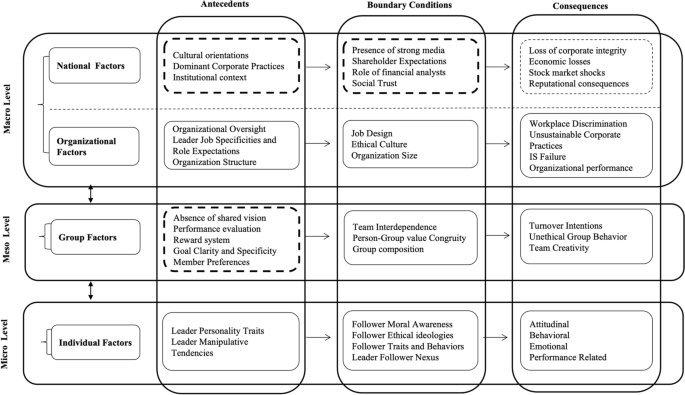
A multi-level M3 framework of unethical leadership
We expect cross-level and reciprocal interactions between these levels, which are functional in unethical leadership processes. For example, at the micro-level, scholars might gauge the influence of individual antecedents, including leaders’ ethical ideologies and personality traits, in terms of their individual, group and organisational consequences. In fact, a reciprocal and cross-level dynamism exists among individual, group and organisational factors. This means a micro-level investigation is not complete unless and until it incorporates macro- and meso-level interventions. For example, an attempt to explore the impact of leader traits on employees’ unethical behaviour would be incomplete if the study did not also account for organisational factors (culture, size and job design). Similarly, macro-level factors, which, in the context of the current study, are conceptualised as national and organisational factors, influence both the occurrence and the consequences of unethical leadership.
We expect national regulatory, normative and cognitive pillars to influence organisational, group and individual factors across the anticipated effects (antecedents, boundary conditions and consequences). Apart from institutional factors, national culture has a trickle-down effect in our framework, which promotes the general and mass prevalence of unethical practices in a country’s organisational, group and individual dynamics. Here again, incorporating meso- and micro-level boundary conditions, e.g. follower morality and ethical group culture, influences the degree and extent of the proposed effect.
Potential Models for Future Research
We offer seven potential research models to direct future scholars in this area.
Potential Model 1
Dark personality traits have largely dominated the discussion regarding the individual-level antecedents of unethical leadership, which leaves ample room for validating the roles of other leader-specific factors. One such factor might be a leader’s inclination towards power and achievement, which could potentially influence his or her proclivity towards unethical practices. Furthermore, this influence could be circumvented or exacerbated by the prevailing institutional conditions in a country, which are related to ethical codes and the morality and legality of actions. We propose a potential model (see Fig. 6 ) based on McClelland’s ( 1985 ) theory of needs and Scott’s ( 1995 ) institutional theory to examine the formation of unethical leadership under the influence of a leader’s individuality as well as the prevailing country-level factors. We propose that leaders are essentially motivated by a certain need to engage in unethical practices, which could be their need for power ( n Pow) or achievement ( n Ach).
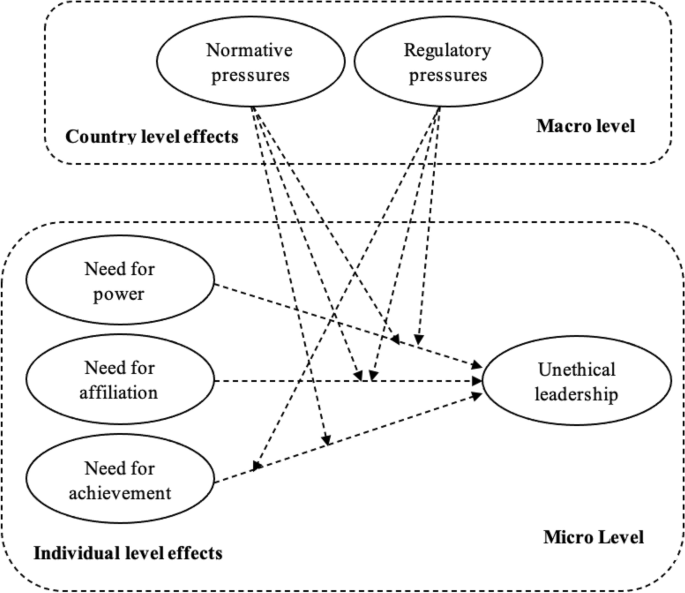
Model of unethical leadership under the framework of institutional theory and theory of needs
Our proposition is informed by the recent literature, which suggests that power and status play a key role in encouraging unethical decisions (Liu et al., 2020 ). Furthermore, we expect a leader’s need for affiliation ( n Aff) to be negatively associated with unethical leadership, given the fact that leaders high in this need are motivated by concerns for the collective welfare and warm interpersonal relationships (Steinmann et al., 2020 ). This effect, however, would likely be conditioned by the laws and regulations in a particular nation as well as by the normative standards of behaviour and beliefs pertaining to the morality of actions. We expect these regulatory and normative macro-level factors to condition the micro-level effect of leader needs on the incidence of unethical leadership. A cross-country study exploring these relationships would, thus, be of immense value.
Potential Model 2
Closely examining Fig. 5 reveals that the extant literature has focused least on group-level mechanisms while completely neglecting group-level antecedents. Thus, to advance group-level mechanisms in the context of unethical leadership, we proposed a model based on social identity theory, fit theory and value congruity theory (see Fig. 7 ). As the model illustrates, group identification maybe a central pivot around which followers categorise themselves in a highly relevant social context and which camouflages the reasoning of individual members under the influence of an unethical leader. Put simply, under the framework of social identity theory (Ashforth et al., 2008 ), individuals develop a sense of shared social categorisation, which is contingent upon the work context in question (Scheepers & Derks, 2016 ). This shared categorisation or in-group membership enables the development of collective or shared group identity, which is expected to result in various group-related outcomes, including group cohesiveness, groupthink and group conformity (Hogg, 2018 ). These effects, however, are contingent upon the fit that a group member perceives between himself or herself and the rest of the group (Cai et al., 2018 ). This ‘compatibility between an individual and his [or her] workgroup’ (Kristof-Brown et al., 2014 ) is likely to enhance the member’s perceptions of his or her collective identity with the group and thereby strengthen groupthink. With studies showing the role of groupthink in constraining ideation and building socially restrictive minds (Fox, 2019 ), we also expect it to foster unethical leadership practices. Therefore, we anticipate that meso-level dynamics will translate into micro-level influences where collective thinking at the group level constrains the honest appraisal of the task under the influence of congruence expected between an employee and his group. Since group-level mechanisms are yet to get fully explored, a qualitative study would be suitable in this direction.

Model of unethical leadership under the framework of fit theory, social identity theory and value congruity theory
Potential Model 3
We highlight the impact of institutional factors on unethical leadership formation under the framework of institutional theory. As discussed in our M3 framework (see Fig. 5 ) and miscellaneous theme, a country’s institutional context may be a significant contributor to unethical leadership. Hence, we propose that institutional uncertainty within a nation—in terms of abruptly changing laws, erratic and random formal procedures and low levels of economic freedom (Boudreaux et al., 2019 )—increases the incidence of unethical behaviours (see Fig. 8 ). We expect political uncertainty, defunct regulatory checks, nepotism and widespread corruption (Kelling et al., 2021 ) to weaken the social and organisational fabric. Such institutional uncertainty also reduces trust among organisational members, which could further encourage unethical leadership practices because lack of trust is considered to be one of the biggest sources of organisational misconduct and malfeasance (Ndalamba, 2019 ). Given the centrality of morality in unethical leadership as depicted in the prior literature (Pelletier & Bligh, 2008 ), however, we contend that this effect is conditional upon the extent to which leaders are morally awake. Therefore, we expect a trickle-down effect under the M3 framework such that macro-level inconsistencies are inflicted upon meso-level (group-level) interactions and, finally, result in micro-level consequences.

Model of unethical leadership under the framework of institutional theory
Potential Model 4
While reviewing the literature on the consequences of unethical leadership, we observed that psychological outcomes have received scant attention. In light of this gap, we developed a research model (see Fig. 9 ) that delineates the psychological costs associated with unethical leadership under the framework of conservation of resource theory (COR). COR is fundamentally a resource conservation strategy through which individuals seek to minimise losses and increase the odds of making gains in work settings (Hobfoll, 2002 ; Hobfoll et al., 2018 ). While material resources initially served as the main elements of interest, psychological resources have increasingly figured into the research context (Qin et al., 2021 ). We observed many investigations of follower-related outcomes in the context of unethical leadership; however, we were unable to locate a single study that ventured into the realm of work–life balance. We contend that unethical leadership has the potential to drain employees of their psychological resources, which may, in turn, deplete their psychological capital and eventually produce burnout. This depletion of resources is also likely to trickle down to affect, causing employees to experience issues in balancing their work and family commitments (Leitão et al., 2019 ). We expect these micro-level interactions to feature at the macro-level in the form of organisational performance.
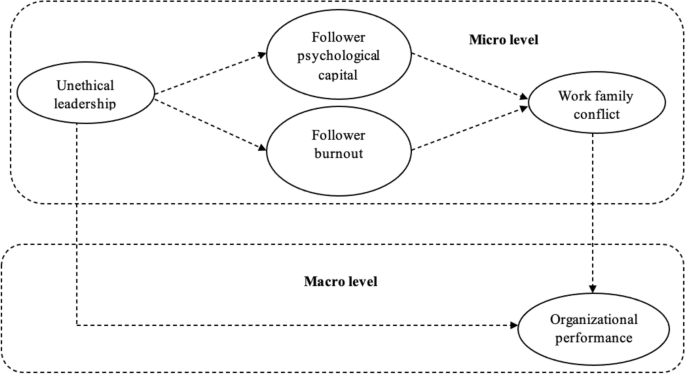
Model of unethical leadership under the framework of conservation of resource theory (COR)
Potential Model 5
In terms of the consequences of unethical leadership, we found a dearth of studies on employee behaviours, with scholars particularly neglecting contemporary behaviours that are influenced by the digitalisation of work. To that end, we propose a research model that captures the impact of unethical leadership on cyber loafing (Fig. 10 ). Cyber loafing is defined as ‘a set of behaviours at work in which an employee engages in electronically mediated activities, particularly through the use of the internet, that his or her immediate supervisor would not consider job-related ’ (Askew et al., 2014 ). We propose that unethical leadership induces cyber loafing through the mediating effect of workplace ostracism among employees. Workplace ostracism refers to the feeling of being socially isolated from the group and the strong perception of oneself as a member of the out-group (Ferris et al., 2008 ). We expect unethical leadership behaviour to provoke this type of workplace aggression as an employee response. This feeling of social isolation among employees in work contexts may result in various deviant workplace behaviours (Yeik, 2018 ). For example, we propose that such exclusion may prompt employees to engage in cyber loafing (i.e. activities and time that employees spend on digital devices and digital content over and above what is demanded by their work). Such deviance could be circumvented, however, by the inherent nature of the job, which may keep employees more engaged and more dependent on their co-workers. Drawing on the job characteristics model (JCM) (Hackman, 1980 ), we propose that when a task is inherently rich in skill variety, the proclivity of employees to roam the Internet and social media may decline. Therefore, we expect a macro-level boundary condition to circumvent the negative impact of unethical leadership on micro-level consequences. Since, we found quantitative traces of job design in the extant literature, exploratory sequential research designs could be employed in future.

Model of unethical leadership under the framework of job design theory and workplace ostracism
Potential Model 6
We developed a model of unethical leadership that delineates its impact on the contemporary forms of organisational performance. Recognising the increasing prominence of sustainability in organisations’ strategic decision making (Nicholson & Kurucz, 2019 ), our sixth model of unethical leadership captures organisations’ green innovation performance (see Fig. 11 ). Working within the micro–macro nexus, we propose a model that links organisational perspectives with individual-level perspectives. At the micro-level, we expect unethical leadership to negatively influence employees’ green creativity, which refers to their novel ideation of green products, green services and pro-environmental solutions (Tuan, 2020 ). Under the framework of COR, we expect employees’ mental exhaustion to negatively influence this creative capacity. However, we also expect organisational structure, which is a macro-level boundary condition, to moderate this effect. In a lean and flexible organisational structure, this effect could be circumvented via the open flow of communication (rather than a hierarchical bureaucratic structure). We also expect unethical leadership to negatively influence green innovation performance under the moderating impact of green human resource management practices. Organisations’ efforts to implement green practices nurture a culture that values and endorses green behaviour and, thus, influence green organisational performance (Mousa & Othman, 2020 ). Furthermore, we suggest that scholars investigate the mediating effect of green creativity on the relationship between unethical leadership and innovation performance and explore the impact of organisation size or culture.

Model of unethical leadership under the framework of the theory of organisational structure and sustainability
Potential Model 7
Given the increasing digitalisation of the workplace and the ethical challenges that accompany this transition, it is important to explore the possible mechanisms through which unethical leader behaviour may result in such situations. We, thus, developed a model (see Fig. 12 ) that links the digitalisation of the workplace with unethical leadership practices. Scholars have predicted the potential of digitalisation to generate ample opportunities for digital fraud (Kumar et al., 2021 ) when broader industry standards regarding technology and its use are largely absent (Foucart & Li, 2021 ).These opportunities, moreover, are ultimately likely to translate into unethical leader behaviour under the influence of organisational size. Indeed, Archambeault and Webber ( 2018 ) showed that both the incidence of fraud and the chances of organisational survival after its discovery are comparatively higher in large rather than small organisations.
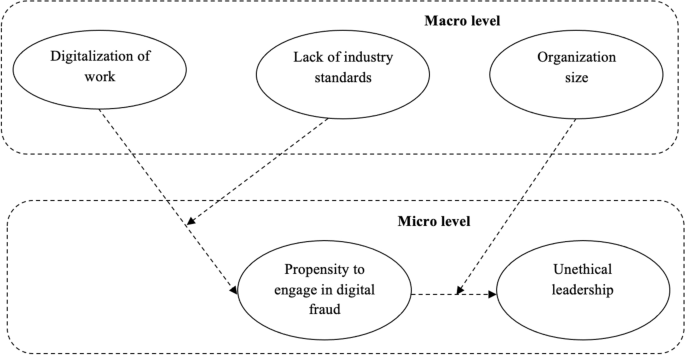
Model of unethical leadership under the framework of the theory of organisational structure and digitalisation of work
Study Implications
Theoretical implications.
The present SLR unravelled various specific underpinnings of the unethical leadership literature while also identifying a good number of areas where impactful research could advance the theoretical robustness of the field.
First and foremost, the present study provides evidence that the field of unethical leadership is not only understudied (i.e. only a small number of studies have actually explored unethical leadership as a distinct concept) but also disjointed. The domain of unethical leadership, in fact, exhibits serious limitations as a result of concept proliferation, which scholars regularly but inappropriately interchange. Seeking to remedy these limitations, our study advances a comprehensive picture of the existing body of work on unethical leadership while also differentiating unethical leadership from other concepts; in doing so, it justifies further investigations of this type of leadership. Having engaged in a nested multi-level analysis of this leadership type, we offer critical insights into the operation of unethical leadership at various levels of analysis.
Second, the present SLR illuminates the prominent theoretical perspectives in the domain of unethical leadership. We assert that theories focused primarily on morality have largely dominated the field. Given the nature of unethical leadership, it is logical to expect the application of such theories, including moral foundations theory (Egorov et al., 2020 ), moral licencing theory (Ahmad et al., 2020 ) and moral self-regulation (Joosten et al., 2014 ). Apart from morality, however, the field of unethical leadership could benefit from the theoretical rigour of other theories. For example, self-determination theory (Rigby & Ryan, 2018 ) may provide a useful theoretical lens to understand the interactions between various levels of employee work motivations (from low quality to high quality) and unethical leadership behaviours, which, in turn, influence job performance. Similarly, the JD-R model (Lesener et al., 2019 )could be used to investigate the role of unethical leadership in increasing job demands (e.g. extra work shifts demanded by the leader) and reducing job resources (e.g. lack of supervisor support) and thereby increasing the psychological and physiological costs associated with a job and influencing various employee outcomes. Furthermore, affective events theory and social information processing theory (Salancik & Pfefer, 1978 ) offer useful theoretical lenses to understand the impact of unethical leadership on emotional labour.
Third, we propose a multi-level framework that identifies antecedents, consequences and boundary mechanisms of unethical leadership at three levels of analysis, i.e. the micro, macro and meso levels. We also identify various individual-, group-, organisational- and country-level factors that could heighten the consequences of unethical leadership. It is important to mention here that the literature pertaining to national-level factors and group-level factors remains scant, and the focus of most studies has been on either individual- or organisational-level factors. Furthermore, employee-related outcomes, especially attitudinal and behavioural outcomes, have received the most attention, which opens ways to understand the impact of unethical leadership on various other outcomes. For example, the impact of unethical leadership on overt employee behaviours, including scouting for a new position and leaving the organisation, has not been conclusively uncovered. Future research can investigate actual exit behaviour resulting from leaders’ unethical conduct. Although one study captured DWBs, we did not locate any research attempting to examine CPBs directed towards the organisation. Similarly, future scholars could investigate group organisational citizenship behaviours to understand the circumstances under which unethical leadership can promote or hinder pro-organisational team behaviours. Again, the extant literature has provided an inadequate account of the impact of unethical leadership on organisational outcomes. Future research can, thus, investigate the impact of unethical leadership on firm performance, market share and firm value. Apart from these outcomes, scholars can explore firm innovation performance and sustainable business model innovation in the context of unethical leadership. Beyond examining various outcomes and antecedents, our framework also highlights the possibility of cross-level interactions among the factors, which can further advance our understanding of unethical leadership. For example, employing hierarchical modelling, scholars can gauge the trickle-down effect of unethical leadership from the individual level to the team level or from the organisational level to the individual level while also considering differences in the outcomes at each level. Specifically, the ethical climate at the organisational level might influence perceptions of ethical leadership at the team level, which, mediated by employee exhaustion and psychological burnout, are likely to produce work–life conflict and an adverse impact on employee well-being.
Fourth, our study advances theory-based potential research models, which future researchers can empirically validate. By relying on well-established theories to clearly identify paths and contextual factors, we advance the theoretical rigour in the area. Informed by our M3 framework, these models provide critical insights into the formation and outcomes of unethical leadership at various levels of analysis. Furthermore, because they are not exhaustive, these models suggest additional investigations in this area.
Finally, we systematically present research gaps in the extant literature. In other words, we identify research gaps pertaining to each theme and propose potential research questions for each thematic category. Given the consequential nature of unethical leadership practices, we believe our research questions can guide scholars who seek to uncover various facets and mechanisms of unethical leadership. For example, our research highlights the outright neglect of the group-level antecedents of unethical leadership. Because team-based structures are here to stay, especially in today's era of digitalisation, efforts to explore this space can be quite valuable to unethical leadership research.
Practical Implications
From a practical standpoint, our work shifts the focus of managers and practitioners towards the gravity of unethical leadership while sensitising them to the diverse factors that can encourage unethical leadership and the strategies that can mitigate its negative effects.
First, our study highlights the critical nature of job design, which, when done appropriately, can serve as a coping mechanism to mitigate the negative effects of unethical leadership. Organisations must strategically design work unit structures to suppress unethical instincts and promote information sharing.
Second, our work entails serious implications for HR practices within organisations. Having highlighted its role in unethical leadership, we assert personality’s importance in the selection process of organisations. In fact, apart from selecting the moral soul, efforts to foster moral character through ethics training and management exercises could have strategic importance. Furthermore, performance appraisals, incentives and promotion avenues can focus on ethicality/unethicality within organisations.
Third, managers and practitioners must understand the centrality of organisational communication, which may act as a buffer against unethical practices. Transparency in information sharing and two-way communication can help to foster ethical values within organisations. This has implications for designing organisational structures by suggesting that managers strategically design flatter structures to reduce the distortion of information.
Fourth, our study signals that unethical leadership is not a short-term phenomenon. At the core of this statement sits the concept of ethical culture, which develops gradually and becomes internalised over decades. Nevertheless, top managers can play a decisive role in aligning their organisations’ strategic maps with those organisations’ ethical considerations. Incorporating ethical facets into the organisational vision may, thus, provide leaders with a sense of direction in disseminating ethical values and achieving their vision.
Finally, our study highlights the role of institutional and cultural factors in influencing the perceptions and emergence of unethical leadership within organisations. This suggests implications at the policy level where the government is entrusted with establishing regulatory conditions to tackle unethical practices at the macro-level. In fact, such policy frameworks can be devised for various sectors of the economy, e.g. the public sector, private sector and NGOs.
The present study provides a systematic account of the academic literature regarding unethical leadership within organisations and offers important theoretical and practical implications for this field of inquiry. We first systematically unravelled the extant work on unethical leadership by providing important descriptive statistics about the yearly progression, theoretical rigour, choice of publication outlet, methodologies, including sampling techniques and unit of analysis, and geographic concentration/diffusion of unethical leadership research. Apart from these descriptive indicators, we also explored how, why and under what conditions unethical leadership is fostered and inhibited in organisational contexts. As a corollary, we developed themes that portray the mechanisms underlying the emergence of unethical leadership. We arranged these themes in the form of a framework that lucidly demonstrates the factors that contribute to its formation and the ways in which the emergence of unethical leadership results in varied types and levels of consequences. To that end, the present study identified the various levels at which unethical leadership research and practice can benefit. We proposed potential research questions pertaining to each level and urge scholars to utilise these questions to expand the existing theoretical and practical understanding of unethical leadership. While we noted a dearth of studies in general, the group and organisational levels appear particularly neglected. Given that contemporary work is increasingly organised around teams, our study advocates for additional investigations of unethical leadership at the group level. Furthermore, we point scholars towards the investigation of particular organisational interventions to reduce the emergence and impact of unethical leadership. Future researchers, finally, can work to empirically validate our well-grounded potential models. These models warrant future investigation at various levels of analysis to understand ways to curb unethical leadership at the macro-level and prevent its occurrence at the micro-level.
Limitations of the Study
The present study has systematically captured the practice of unethical leadership within organisations, identified knowledge gaps in the existing literature and provided relevant future research directions. Despite its contributions, however, our study entails some limitations, which future research should address. First and foremost, our literature search was confined to Scopus and the Web of Science databases. Although these databases include most of the reputed journals, we suspect that we may have missed some relevant and potentially useful studies. Therefore, future research can mine other databases to address this limitation. Second, following best practices, one of our screening criteria excluded various publication sources, such as conference proceedings, book chapters, thesis work and non-peer-reviewed journals. Future scholars can, thus, incorporate these sources in their work, including studies written in languages other than English. Finally, although systematic reviews are valuable, the method itself is not devoid of limitations. Therefore, future research should conduct meta-analyses to provide more robust and statistical support for our findings.
Aghaei, M., Nasr Isfahani, A., Ghorbani, A., & Roozmand, O. (2021). Implicit followership theories and resistance to leaders’ unethical requests: The mediating role of organizational citizenship behavior. International Journal of Organizational Analysis . https://doi.org/10.1108/IJOA-06-2021-2830
Article Google Scholar
Ahmad, K. Z., Jasimuddin, S., & Kee, W. (2018). Organizational climate and job satisfaction: Do employees’ personalities matter? Management Decision, 56 (2), 421–440.
Ahmad, M. G., Klotz, A. C., & Bolino, M. C. (2020). Can good followers create unethical leaders? How follower citizenship leads to leader moral licensing and unethical behavior. Journal of Applied Psychology, 106 , 1374. https://doi.org/10.1037/apl0000839
Akstinaite, V., Robinson, G., & Sadler-Smith, E. (2020). Linguistic markers of CEO hubris. Journal of Business Ethics, 167 (4), 687–705. https://doi.org/10.1007/s10551-019-04183-y
Almeida, J. G., Hartog, D. N. D., De Hoogh, A. H. B., Franco, V. R., & Porto, J. B. (2021). Harmful leader behaviors: Toward an increased understanding of how different forms of unethical leader behavior can harm subordinates. Journal of Business Ethics . https://doi.org/10.1007/s10551-021-04864-7
Archambeault, D. S., & Webber, S. (2018). Fraud survival in nonprofit organizations: Empirical evidence. Nonprofit Management and Leadership, 29 (1), 29–46. https://doi.org/10.1002/nml.21313
Ashforth, B. E. (1997). Petty tyranny in organizations: A preliminary examination of antecedents and consequences. Canadian Journal of Administrative Sciences, 14 , 126–140.
Ashforth, B. E., Harrison, S. H., & Corley, K. G. (2008). Identification in organizations: An examination of four fundamental questions. Journal of Management, 34 (3), 325–374. https://doi.org/10.1177/0149206308316059
Askew, K., Buckner, J. E., Taing, M. U., Ilie, A., Bauer, J. A., & Coovert, M. D. (2014). Explaining cyberloafing: The role of the theory of planned behavior. Computers in Human Behavior, 36 , 510–519. https://doi.org/10.1016/j.chb.2014.04.006
Auvinen, T. P., Lämsä, A. M., Sintonen, T., & Takala, T. (2013). Leadership manipulation and ethics in storytelling. Journal of Business Ethics, 116 (2), 415–431. https://doi.org/10.1007/s10551-012-1454-8
Barbour, J. B. (2017). Micro/meso/macrolevels of analysis. The International Encyclopedia of Organizational Communication . https://doi.org/10.1002/9781118955567.wbieoc140
Barling, J., Christie, A., & Turner, N. (2008). Pseudo-transformational leadership: Towards the development and test of a model. Journal of Business Ethics, 81 (4), 851–861. https://doi.org/10.1007/s10551-007-9552-8
Belschak, F. D., Muhammad, R. S., & Den Hartog, D. N. (2018). Birds of a feather can butt heads: when machiavellian employees work with Machiavellian leaders. Journal of Business Ethics, 151 (3), 613–626. https://doi.org/10.1007/s10551-016-3251-2
Benlahcene, A., & Meddour, H. (2020). The prevalence of unethical leadership behaviour : The role of organisational oversight. Prevalence, 13 (4), 310–325.
Google Scholar
Blair, C. A., Helland, K., & Walton, B. (2017). Leaders behaving badly: The relationship between narcissism and unethical leadership. Leadership and Organization Development Journal . https://doi.org/10.1108/LODJ-09-2015-0209
Boddy, C. R. (2016). Unethical 20th century business leaders. International Journal of Public Leadership, 12 (2), 76–93. https://doi.org/10.1108/ijpl-12-2015-0032
Boudreaux, C. J., Nikolaev, B. N., & Klein, P. (2019). Socio-cognitive traits and entrepreneurship: The moderating role of economic institutions. Journal of Business Venturing, 34 (1), 178–196. https://doi.org/10.1016/j.jbusvent.2018.08.003
Brown, M. E., Treviño, L. K., & Harrison, D. A. (2005). Ethical leadership: A social learning perspective for construct development and testing. Organizational Behavior and Human Decision Processes, 97 , 117–134.
Brown, M., & Mitchell, M. (2010). Ethical and unethical leadership: Exploring new avenues for future research. Business Ethics Quarterly, 20 (4), 583–616. https://doi.org/10.5840/beq201020439
Cable, D. M., & De Rue, D. S. (2002). The convergent and discriminant validity of subjective fit perceptions. Journal of Applied Psychology, 87 , 875–884.
Cai, D., Cai, Y., Sun, Y., & Ma, J. (2018). Linking empowering leadership and employee work engagement: The effects of person-job fit, person-group fit, and proactive personality. Frontiers in Psychology . https://doi.org/10.3389/fpsyg.2018.01304
Campbell, W. K., Hoffman, B. J., Campbell, S., & Marchisio, G. (2011). Narcissism in organizational contexts. Human Resource Management Review, 21 , 268–284.
Carsten, M. K., & Uhl-Bien, M. (2012). Follower beliefs in the co-production of leadership: Examining upward commu_nication and the moderating role of context. Zeitschrift Für Psychologie, 220 , 210–220.
Carsten, M. K., & Uhl-Bien, M. (2013). Ethical followership: An examination of followership beliefs and crimes of obedience. Journal of Leadership & Organizational Studies, 20 (1), 49–61.
Charoensap, A., Virakul, B., Senasu, K., & Ayman, R. (2018). Effect of ethical leadership and interactional justice on employee work attitudes. Journal of Leadership Studies, 12 (4), 7–26. https://doi.org/10.1002/jls.21574
Chen, S. (2010a). Bolstering unethical leaders: The role of the media, financial analysts and shareholders. Journal of Public Affairs, 10 (3), 200–215. https://doi.org/10.1002/pa.356
Chen, S. (2010b). The role of ethical leadership versus institutional constraints: A simulation study of financial misreporting by CEOs. Journal of Business Ethics, 93 (SUPPL. 1), 33–52. https://doi.org/10.1007/s10551-010-0625-8
Cialdini, R., Li, Y. J., Samper, A., & Wellman, N. (2021). How bad apples promote bad barrels: Unethical leader behavior and the selective attrition effect. Journal of Business Ethics, 168 (4), 861–880. https://doi.org/10.1007/s10551-019-04252-2
D’Adda, G., Darai, D., & Weber, R. (2014). Do leaders affect ethical conduct? (No. 167).
Davis, M., Cox, M., & Baucus, M. (2021). Managerial aspirations and suspect leaders: The effect of relative performance and leader succession on organizational misconduct. Journal of Business Ethics, 171 (1), 123–138. https://doi.org/10.1007/s10551-019-04245-1
De Hoogh, A. H. B., & Den Hartog, D. N. (2008). Ethical and despotic leadership, relationships with leader’s social responsibility, top management team effectiveness and subordinates’ optimism: A multi-method study. The Leadership Quarterly, 19 , 297–311.
Desai, S. D., & Kouchaki, M. (2017). Moral symbols: A necklace of garlic against unethical requests. Academy of Management Journal . https://doi.org/10.5465/amj.2015.0008
Dorn, S., Schweiger, B., & Albers, S. (2016). Levels, phases and themes of coopetition: A systematic literature review and research agenda. European Management Journal, 34 (5), 484–500. https://doi.org/10.1016/j.emj.2016.02.009
Duckworth, A. L., Peterson, C., Matthews, M. D., & Kelly, D. R. (2007). Grit: Perseverance and passion for long-term goals. Journal of Personality and Social Psychology, 92 , 1087–1101.
Duffy, M. K., Ganster, D. C., & Pagon, M. (2002). Social undermining in the workplace. Academy of Management Journal, 45 , 331–351.
Earnest &Young. (2020). Global Integrity Report .
Egorov, M., Kalshoven, K., Pircher Verdorfer, A., & Peus, C. (2020). It’s a match: Moralization and the effects of moral foundations congruence on ethical and unethical leadership perception. Journal of Business Ethics, 167 (4), 707–723. https://doi.org/10.1007/s10551-019-04178-9
Einarsen, S., Aasland, M. S., & Skogstad, A. (2007). Destructive leadership behaviour: A definition and conceptual model. The Leadership Quarterly, 18 , 207–216.
Eisenbeiß, S. A., & Brodbeck, F. (2014). Ethical and unethical leadership: A cross-cultural and cross-sectoral analysis. Journal of Business Ethics, 122 (2), 343–359. https://doi.org/10.1007/s10551-013-1740-0
Fehr, R., Fulmer, A., & Keng-Highberger, F. T. (2020). How do employees react to leaders’ unethical behavior? The role of moral disengagement. Personnel Psychology, 73 (1), 73–93. https://doi.org/10.1111/peps.12366
Ferris, D. L., Brown, D. J., Berry, J. W., & Lian, H. (2008). The development and validation of the workplace ostracism scale. Journal of Applied Psychology . https://doi.org/10.1037/a0012743
Foucart, R., & Li, Q. C. (2021). The role of technology standards in product innovation: Theory and evidence from UK manufacturing firms. Research Policy, 50 (2), 104157. https://doi.org/10.1016/j.respol.2020.104157
Fox, S. (2019). Addressing the influence of groupthink during ideation concerned with new applications of technology in society. Technology in Society . https://doi.org/10.1016/j.techsoc.2018.12.009
Gan, C., Guo, W., Chai, Y., & Wang, D. (2019). Unethical leader behavior and employee performance: A deontic justice perspective. Personnel Review, 49 (1), 188–201. https://doi.org/10.1108/PR-08-2018-0290
Gardner, W. L., & Cogliser, C. C. (2009). Meso-modeling of leadership: Following James G. (Jerry) Hunt’s lead in integrating micro- and macro-perspectives of leadership. Leadership Quarterly, 20 (4), 493–500. https://doi.org/10.1016/j.leaqua.2009.04.001
Giessner, S., & van Quaquebeke, N. (2010). Using a relational models perspective to understand normatively appropriate conduct in ethical leadership. Journal of Business Ethics, 95 (SUPPL. 1), 43–55. https://doi.org/10.1007/s10551-011-0790-4
Glaser, B., & Strauss, A. (1967). The discovery of grounded theory: strategies for qualitative research. Mill Valley, CA: Sociology Press.
Goncalo, J. A., & Staw, B. M. (2006). Individualism-collectivism and group creativity. Organizational Behavior and Human Decision Processes, 100 (1), 96–109.
Grover, S. L., & Hasel, M. C. (2018). The Ironic double whammy of being an ethical leader : follower response to leader infidelity . 21 .
Guo, L., Zhao, H., Cheng, K., & Luo, J. (2020). The relationship between abusive supervision and unethical pro-organizational behavior: Linear or curvilinear? Leadership and Organization Development Journal, 41 (3), 369–381. https://doi.org/10.1108/LODJ-05-2019-0214
Hackman, J. R. (1980). Work redesign and motivation. Professional Psychology, 11 (3), 445–455. https://doi.org/10.1037/0735-7028.11.3.445
Hartman, L. P. (2000). Moral person and moral manager. California Management Review, 42 (4), 128–143.
Hobfoll, S. E. (2002). Social and psychological resources and adaptation. Review of General Psychology, 6 (4), 307–324. https://doi.org/10.1037/1089-2680.6.4.307
Hobfoll, S. E., Halbesleben, J., Neveu, J.-P., & Westman, M. (2018). Conservation of resources in the organizational context: The reality of resources and their consequences. Annual Review of Organizational Psychology and Organizational Behavior, 5 (1), 103–128. https://doi.org/10.1146/annurev-orgpsych-032117-104640
Hoffman, B. J., Strang, S. E., Kuhnert, K. W., Campbell, W. K., Kennedy, C. L., & Lopilato, A. C. (2013). Leader narcissism and ethical context: Effects on ethical leadership and leader effectiveness. Journal of Leadership and Organizational Studies, 20 (1), 25–37. https://doi.org/10.1177/1548051812465891
Hogg, M. A. (2018). Social identity, self-categorization, and the small group. Understanding group behavior (pp. 227–253). Psychology Press.
Chapter Google Scholar
Hoyt, C. L., Price, T. L., & Poatsy, L. (2013). The social role theory of unethical leadership. Leadership Quarterly, 24 (5), 712–723. https://doi.org/10.1016/j.leaqua.2013.07.001
Javaid, M. F., Raoof, R., Farooq, M., & Arshad, M. (2020). Unethical leadership and crimes of obedience: A moral awareness perspective. Global Business and Organizational Excellence, 39 (5), 18–25. https://doi.org/10.1002/joe.22011
Johnson, E. N., Kidwell, L. A., Lowe, D. J., & Reckers, P. M. J. (2017). Who follows the unethical leader ? The association between followers ’ personal characteristics and intentions to comply in committing organizational fraud. Journal of Business Ethics . https://doi.org/10.1007/s10551-017-3457-y
Joosten, A., van Dijke, M., Van Hiel, A., & De Cremer, D. (2014). Being “in control” may make you lose control: The role of self-regulation in unethical leadership behavior. Journal of Business Ethics, 121 (1), 1–14. https://doi.org/10.1007/s10551-013-1686-2
Jung, J. C., & Sharon, E. (2019). The Volkswagen emissions scandal and its aftermath. Global Business and Organizational Excellence, 38 (4), 6–15.
Kabat-Farr, D., Walsh, B. M., & McGonagle, A. K. (2019). Uncivil supervisors and perceived work ability: The joint moderating roles of job involvement and grit. Journal of Business Ethics, 156 (4), 971–985. https://doi.org/10.1007/s10551-017-3604-5
Kaptein, M. (2011). Understanding unethical behavior by unraveling ethical culture. Human Relations, 64 (6), 843–869.
Kaur, P., Dhir, A., Tandon, A., Alzeiby, E. A., & Abohassan, A. A. (2021). A systematic literature review on cyberstalking. An analysis of past achievements and future promises. Technological Forecasting and Social Change, 163 , 120426. https://doi.org/10.1016/j.techfore.2020.120426
Kelling, N. K., Sauer, P. C., Gold, S., & Seuring, S. (2021). The role of institutional uncertainty for social sustainability of companies and supply chains. Journal of Business Ethics . https://doi.org/10.1007/s10551-020-04423-6
Khan, S. J., Kaur, P., Jabeen, F., & Dhir, A. (2021). Green process innovation: Where we are and where we are going. Business Strategy and the Environment, 30 , 3273–3296. https://doi.org/10.1002/bse.2802
Kimura, T., & Nishikawa, M. (2018). Ethical leadership and its cultural and institutional context: An empirical study in Japan. Journal of Business Ethics, 151 (3), 707–724. https://doi.org/10.1007/s10551-016-3268-6
Knoll, M., Schyns, B., & Petersen, L. E. (2017). How the influence of unethical leaders on followers is affected by their implicit followership theories. Journal of Leadership and Organizational Studies, 24 (4), 450–465. https://doi.org/10.1177/1548051817705296
Kristof-Brown, A. L., Zimmerman, R. D., & Johnson, E. C. (2005). Consequences of Individuals’ fit at work: A meta-analysis of per_son–job, person–organization, person–group, and person–supervisor fit. Personnel Psychology, 58 , 281–342.
Kristof-Brown, A. L., Seong, J. Y., Degeest, D. S., Park, W. W., & Hong, D. S. (2014). Collective fit perceptions: A multilevel investigation of person-group fit with individual-level and team-level outcomes. Journal of Organizational Behavior . https://doi.org/10.1002/job.1942
Kumar, R., Sindhwani, R., & Singh, P. L. (2021). IIoT implementation challenges: Analysis and mitigation by blockchain. Journal of Global Operations and Strategic Sourcing . https://doi.org/10.1108/JGOSS-08-2021-0056
Kwon, B., Farndale, E., & Park, J. G. (2016). Employee voice and work engagement: Macro, meso, and micro-level drivers of convergence? Human Resource Management Review, 26 (4), 327–337. https://doi.org/10.1016/j.hrmr.2016.04.005
Landis, J. R., & Koch, G. G. (1977). An application of hierarchical kappa-type statistics in the assessment of majority agreement among multiple observers. Biometrics, 33 (2), 363. https://doi.org/10.2307/2529786
Lašáková, A., & Remišová, A. (2015). Unethical leadership: Current theoretical trends and conceptualization. Procedia Economics and Finance, 34 , 319–328. https://doi.org/10.1016/S2212-5671(15)01636-6
Lašáková, A., & Remišová, A. (2019). The relationship between demographic factors and managers’ perception of unethical tone at the top. Journal of Management Development, 38 (1), 25–45. https://doi.org/10.1108/JMD-07-2018-0213
Leitão, J., Pereira, D., & Gonçalves, Â. (2019). Quality of work life and organizational performance: Workers’ feelings of contributing, or not, to the organization’s productivity. International Journal of Environmental Research and Public Health . https://doi.org/10.3390/ijerph16203803
Lesener, T., Gusy, B., & Wolter, C. (2019). The job demands-resources model: A meta-analytic review of longitudinal studies. Work and Stress, 33 (1), 76–103. https://doi.org/10.1080/02678373.2018.1529065
Liu, Y., Chen, S., Bell, C., & Tan, J. (2020). How do power and status differ in predicting unethical decisions? A cross-national comparison of China and Canada. Journal of Business Ethics . https://doi.org/10.1007/s10551-019-04150-7
Mackey, J. D., Frieder, R. E., Brees, J. R., & Martinko, M. J. (2017). Abusive supervision: A meta-analysis and empirical review. Journal of Management, 43 (6), 1940–1965.
Mackey, J. D., Parker Ellen, B., McAllister, C. P., & Alexander, K. C. (2021). The dark side of leadership: A systematic literature review and meta-analysis of destructive leadership research. Journal of Business Research, 132 , 705–718. https://doi.org/10.1016/j.jbusres.2020.10.037
Markham, S. E. (2010). Leadership, levels of analysis, and déjà vu: Modest proposals for taxonomy and cladistics coupled with replication and visualization. Leadership Quarterly, 21 (6), 1121–1143. https://doi.org/10.1016/j.leaqua.2010.10.011
Marshall, A., Ashleigh, M., Baden, D., Ojiako, U., & Guidi, M. (2014). Corporate psychopathy: Can ‘search and destroy’ and ‘hearts and minds’ military metaphors inspire HRM solutions? Journal of Business Ethics, 128 (3), 1–10.
McClelland, D., C. (1985). How motives, skills, and values determine what people do. American Psychologist , 40 (7), 812–825. https://doi.org/10.1037/0003-066X.40.7.812
McGonagle, A. K., Fisher, G. G., Barnes-Farrell, J. L., & Grosch, J. (2015). Individual and work factors related to perceived work ability and labor force outcomes. Journal of Applied Psychology, 100 , 376–398.
Mcmanus, J. (2016). Hubris and unethical decision making : The tragedy of the uncommon. Journal of Business Ethics . https://doi.org/10.1007/s10551-016-3087-9
Mishra, M., Ghosh, K., & Sharma, D. (2021). Unethical pro-organizational behavior: A systematic review and future research agenda. Journal of Business Ethics . https://doi.org/10.1007/s10551-021-04764-w
Mongeon, P., & Paul-Hus, A. (2016). The journal coverage of Web of Science and Scopus: A comparative analysis. Scientometrics, 106 (1), 213–228.
Morgeson, F. P., & Humphrey, S. E. (2006). The Work Design Questionnaire (WDQ): Developing and validating a comprehensive measure for assessing job design and the nature of work. Journal of Applied Psychology, 91 (6), 1321–1339.
Morrison, E. W. (2014). Employee voice and silence. Annual Review of Organizational Psychology and Organizational Behavior, 1 , 173–197.
Mousa, S. K., & Othman, M. (2020). The impact of green human resource management practices on sustainable performance in healthcare organisations: A conceptual framework. Journal of Cleaner Production, 243 , 118595. https://doi.org/10.1016/j.jclepro.2019.118595
Moutousi, O., & May, D. (2018). How change-related unethical leadership triggers follower resistance to change: A theoretical account and conceptual model. Journal of Change Management, 18 (2), 142–161. https://doi.org/10.1080/14697017.2018.1446695
Mujkic, E., & Klingner, D. (2019). Dieselgate: How hubris and bad leadership caused the biggest scandal in automotive history. Public Integrity, 21 (4), 365–377. https://doi.org/10.1080/10999922.2018.1522180
Ndalamba, K. K. (2019). An exploration into the problematic public policies and the leadership challenge for socio-economic transformation in South Africa. International Journal of Excellence in Government . https://doi.org/10.1108/ijeg-09-2018-0003
Neuman, J. H., & Baron, R. A. (1998). Workplace violence and workplace aggression: Evidence concerning specific forms, potential causes, and preferred targets. Journal of Management, 24 (3), 391–419.
Newman, A., Le, H., North, A., & Michael, S. (2020). Moral disengagement at work : A review and research agenda. Journal of Business Ethics, 167 (3), 535. https://doi.org/10.1007/s10551-019-04173-0
Nicholson, J., & Kurucz, E. (2019). Relational leadership for sustainability: Building an ethical framework from the moral theory of ‘ethics of care.’ Journal of Business Ethics, 156 (1), 25–43. https://doi.org/10.1007/s10551-017-3593-4
Pandey, S., DeHart-Davis, L., Pandey, S., & Ahlawat, S. (2021). Fight or flight: How gender influences follower responses to unethical leader behaviour? Public Management Review . https://doi.org/10.1080/14719037.2021.2000220
Pelletier, K. L., & Bligh, M. C. (2008). The aftermath of organizational corruption: Employee attributions and emotional reactions. Journal of Business Ethics, 80 (4), 823–844. https://doi.org/10.1007/s10551-007-9471-8
Peng, A. C., Schaubroeck, J. M., Chong, S., & Li, Y. (2019). Discrete emotions linking abusive supervision to employee intention and behavior. Personnel Psychology, 72 (3), 393–419. https://doi.org/10.1111/peps.12310
Peng, J., Wang, Z., & Chen, X. (2019). Does self-serving leadership hinder team creativity? A moderated dual-path model. Journal of Business Ethics, 159 (2), 419–433. https://doi.org/10.1007/s10551-018-3799-0
Petit, V., & Bollaert, H. (2012). Flying too close to the sun? Hubris among CEOs and how to prevent it. Journal of Business Ethics, 108 (3), 265–283. https://doi.org/10.1007/s10551-011-1097-1
PwC. (2020). Global Economic Crime and Fraud Survey 2020 .
Qin, Y., Xie, Y., & Cooke, F. L. (2021). Unethical leadership and employee knowledge-hiding behavior in the Chinese context: A moderated dual-pathway model. Asian Business and Management . https://doi.org/10.1057/s41291-021-00154-2
Resick, C. J., Martin, G. S., Keating, M. A., Dickson, M. W., Kwan, H. K., & Peng, C. (2011). What ethical leadership means to me: Asian, American, and European perspectives. Journal of Business Ethics, 101 (3), 435–457. https://doi.org/10.1007/s10551-010-0730-8
Rigby, C. S., & Ryan, R. M. (2018). Self-determination theory in human resource development: New directions and practical considerations. Advances in Developing Human Resources, 20 (2), 133–147. https://doi.org/10.1177/1523422318756954
Roberts, A. (2020). Bridging levels of public administration: How macro shapes meso and micro. Administration and Society, 52 (4), 631–656. https://doi.org/10.1177/0095399719877160
Roque, A., Moreira, J. M., Dias Figueiredo, J., Albuquerque, R., & Gonçalves, H. (2020). Ethics beyond leadership: Can ethics survive bad leadership? Journal of Global Responsibility, 11 (3), 275–294. https://doi.org/10.1108/jgr-06-2019-0065
Ruiz-Palomino, P., Martínez-Cañas, R., & Bañón-Gomis, A. (2021). Is unethical leadership a negative for Employees’ personal growth and intention to stay? The buffering role of responsibility climate. European Management Review . https://doi.org/10.1111/emre.12461
Salancik, G. R., & Pfefer, J. (1978). A social information processing approach to job attitudes and task design. Administrative Science Quarterly, 23 (2), 224–253.
Scheepers, D., & Derks, B. (2016). Revisiting social identity theory from a neuroscience perspective. Current Opinion in Psychology . https://doi.org/10.1016/j.copsyc.2016.06.006
Schriesheim, C. A., Wu, J. B., & Scandura, T. A. (2009). A meso measure? Examination of the levels of analysis of the Multifactor Leadership Questionnaire (MLQ). Leadership Quarterly, 20 (4), 604–616. https://doi.org/10.1016/j.leaqua.2009.04.005
Schyns, B., & Schilling, J. (2013). How bad are the effects of bad leaders? A meta-analysis of destructive leadership and its outcomes. Leadership Quarterly, 24 (1), 138–158. https://doi.org/10.1016/j.leaqua.2012.09.001
Scott, W. R. (1995). Institutions and organizations. Thousand Oaks, CA: Sage Publications.
Segon, M., & Booth, C. (2015). Virtue : The missing ethics element in emotional intelligence. Journal of Business Ethics, 128 , 789–802. https://doi.org/10.1007/s10551-013-2029-z
Seth, H., Talwar, S., Bhatia, A., Saxena, A., & Dhir, A. (2020). Consumer resistance and inertia of retail investors: Development of the resistance adoption inertia continuance (RAIC) framework. Journal of Retailing and Consumer Services, 55 , 102071.
Shamsollahi, A., Chmielewski-Raimondo, D. A., Bell, S. J., & Kachouie, R. (2021). Buyer–supplier relationship dynamics: A systematic review. Journal of the Academy of Marketing Science, 49 (2), 418–436. https://doi.org/10.1007/s11747-020-00743-1
Sherif, K., Pitre, R., & Kamara, M. (2016). Why do information system controls fail to prevent unethical behavior? VINE Journal of Information and Knowledge Management Systems, 46 (2), 251–266. https://doi.org/10.1108/VJIKMS-04-2015-0028
Sims, R. R., & Brinkmann, J. (2003). Enron ethics (Or: Culture matters more than codes). Journal of Business Ethics, 45 , 243–256.
Solas, J. (2016). The banality of bad leadership and followership. Society and Business Review, 11 (1), 12–23. https://doi.org/10.1108/sbr-09-2015-0049
Steinmann, B., Kleinert, A., & Maier, G. W. (2020). Promoting the underestimated: A vignette study on the importance of the need for affiliation to successful leadership. Motivation and Emotion, 44 (5), 641–656. https://doi.org/10.1007/s11031-020-09833-7
Stouten, J., Tripp, T. M., Bies, R. J., & Cremer, D. D. (2019). When something is not right : The value of silence. Academy of Management Perspectives, 33 (3), 323–333.
Stouten, J., van Dijke, M., Mayer, D. M., De Cremer, D., & Euwema, M. C. (2013). Can a leader be seen as too ethical? The curvilinear effects of ethical leadership. Leadership Quarterly . https://doi.org/10.1016/j.leaqua.2013.05.002
Talwar, S., Talwar, M., Kaur, P., & Dhir, A. (2020). Consumers’ resistance to digital innovations: A systematic review and framework development. Australasian Marketing Journal, 28 (4), 286–299.
Tepper, B. J. (2000). Consequences of abusive supervision. Academy of Management Journal, 43 , 178–190.
Tepper, B. J., & Henle, C. A. (2011). A case for recognizing distinctions among constructs that capture interpersonal mis_treatment in work organizations. Journal of Organizational Behavior, 32 , 487–498.
Tranfield, D., Denyer, D., & Smart, P. (2003). Towards a methodology for developing evidence-informed management knowledge by means of systematic review. British Journal of Management, 14 (3), 207–222. https://doi.org/10.1111/1467-8551.00375
Tuan, L. T. (2020). Environmentally-specific servant leadership and green creativity among tourism employees: Dual mediation paths. Journal of Sustainable Tourism, 28 (1), 86–109. https://doi.org/10.1080/09669582.2019.1675674
Uhl-Bien, M., Riggio, R. E., Lowe, K. B., & Carsten, M. K. (2014). Followership theory: A review and research agenda. The Leadership Quarterly, 25 (1), 83–104.
Ünal, A. F., Warren, D. E., & Chen, C. C. (2012). The normative foundations of unethical supervision in organizations. Journal of Business Ethics, 107 (1), 5–19. https://doi.org/10.1007/s10551-012-1300-z
Vasconcelos, A. F. (2015). Portraying some determinants of discrimination in the workplace. The Journal of the Iberoamerican Academy of Management, 13 (2), 211–232.
Wood, R., & Bandura, A. (1989). Impact of conceptions of ability on self-regulatory mechanisms and complex decision making. Journal of Personality and Social Psychology, 56 (3), 407–415. https://doi.org/10.1037/0022-3514.56.3.407
Yeik, K. K. (2018). Workplace ostracism and cyberloafing : A moderated-mediation model. Internet Research Article Information . https://doi.org/10.1108/IntR-07-2017-0268
Zhang, Y., & Bednall, T. C. (2016). Antecedents of abusive supervision: A meta-analytic review. Journal of Business Ethics, 139 (3), 455–471. https://doi.org/10.1007/s10551-015-2657-6
Zhao, H., & Li, C. (2019). A computerized approach to understanding leadership research. Leadership Quarterly . https://doi.org/10.1016/j.leaqua.2019.06.001
Zheng, F., Khan, N. A., & Khan, M. W. A. (2021). Unethical leadership and employee extra-role behavior in information technology sector: A moderated mediation analysis. In Frontiers in Psychology . https://doi.org/10.3389/fpsyg.2021.708016
Zoghbi-Manrique-de-Lara, P., & Suárez-Acosta, M. A. (2014). Employees’ reactions to peers’ unfair treatment by supervisors: The role of ethical leadership. Journal of Business Ethics, 122 (4), 537–549. https://doi.org/10.1007/s10551-013-1778-z
Download references
Open access funding provided by University of Agder.
Author information
Authors and affiliations.
Department of Management Studies, University of Kashmir, Srinagar, India
Sharfa Hassan
Department of Psychosocial Science, University of Bergen, Bergen, Norway
Puneet Kaur
Optentia Research Focus Area, North-West University, Vanderbijlpark, South Africa
Puneet Kaur & Amandeep Dhir
School of Management, College of Business and Law, RMIT University, Melbourne, Australia
Michael Muchiri
Department of Leadership & Management, Kent Business School, Canterbury, UK
Chidiebere Ogbonnaya
Department of Management, School of Business & Law, University of Agder, Kristiansand, Norway
Amandeep Dhir
Jaipuria Institute of Management, Noida, India
You can also search for this author in PubMed Google Scholar
Corresponding author
Correspondence to Amandeep Dhir .
Ethics declarations
Conflict of interest.
The authors do not have any competing interests to declare.
Additional information
Publisher's note.
Springer Nature remains neutral with regard to jurisdictional claims in published maps and institutional affiliations.
Rights and permissions
Open Access This article is licensed under a Creative Commons Attribution 4.0 International License, which permits use, sharing, adaptation, distribution and reproduction in any medium or format, as long as you give appropriate credit to the original author(s) and the source, provide a link to the Creative Commons licence, and indicate if changes were made. The images or other third party material in this article are included in the article's Creative Commons licence, unless indicated otherwise in a credit line to the material. If material is not included in the article's Creative Commons licence and your intended use is not permitted by statutory regulation or exceeds the permitted use, you will need to obtain permission directly from the copyright holder. To view a copy of this licence, visit http://creativecommons.org/licenses/by/4.0/ .
Reprints and permissions
About this article
Hassan, S., Kaur, P., Muchiri, M. et al. Unethical Leadership: Review, Synthesis and Directions for Future Research. J Bus Ethics 183 , 511–550 (2023). https://doi.org/10.1007/s10551-022-05081-6
Download citation
Received : 24 July 2021
Accepted : 20 February 2022
Published : 18 March 2022
Issue Date : March 2023
DOI : https://doi.org/10.1007/s10551-022-05081-6
Share this article
Anyone you share the following link with will be able to read this content:
Sorry, a shareable link is not currently available for this article.
Provided by the Springer Nature SharedIt content-sharing initiative
- Unethical leadership
- Systematic literature review
- Multi-level analysis
- Group-level factors
- Individual-level factors
- Organisational-level factors
- Find a journal
- Publish with us
- Track your research
Mobile Menu Overlay
The White House 1600 Pennsylvania Ave NW Washington, DC 20500
United States-Japan Joint Leaders’ Statement
Global Partners for the Future
Over the course of the last three years, the U.S.-Japan Alliance has reached unprecedented heights. We arrived at this historic moment because our nations, individually and together, took courageous steps to strengthen our collective capacity in ways that would have seemed impossible just a few years ago. Today, we, President Joseph R. Biden, Jr. and Prime Minister KISHIDA Fumio, celebrate this new era of U.S.-Japan strategic cooperation during the Prime Minister’s Official Visit and State Dinner in Washington, D.C.—and pledge that the United States and Japan will continue our tireless work, together and with other partners, to realize a free and open Indo-Pacific and world.
In this new era of U.S.-Japan cooperation, we recognize that global events affect the security and stability of the Indo-Pacific, and that developments in our shared region reverberate around the world. We are therefore working together, across all domains and at all levels, to build a global partnership that is fit for purpose to address the complex, interconnected challenges of today and tomorrow for the benefit of our two countries and the world. As our Alliance cooperation reaches new heights, we are expanding our engagement to reflect the global nature of our partnership.
At the core of our cooperation is a shared commitment to work with like-minded partners and multilateral institutions to address common challenges and to ensure a world that is free, open, connected, resilient, and secure. These joint efforts are based on our shared fundamental respect for international law, including the protection and promotion of human rights and dignity, the sovereignty and territorial integrity of all states, and the prohibition on acquisition of territory by force. Our purpose as partners is to uphold and bolster the free and open international order based on the rule of law that has allowed so many nations to develop and prosper, and to ensure our Alliance is equipped to tackle the challenges of the 21 st century.
To advance our global partnership, today we announce several new strategic initiatives to strengthen our defense and security cooperation; reach new frontiers in space; drive technology innovation; bolster economic security; accelerate climate action; partner on global diplomacy and development; and fortify the ties between our peoples. Through our global partnership, we are also synchronizing our strategies, and our two nations have never been more united as we work together to address the most pressing challenges and opportunities of the future.
Strengthening our Defense and Security Cooperation
The core of our global partnership is our bilateral defense and security cooperation under the Treaty of Mutual Cooperation and Security, which is stronger than ever. We affirm that our Alliance remains the cornerstone of peace, security, and prosperity in the Indo-Pacific. President Biden reiterated the unwavering commitment of the United States to the defense of Japan under Article V of the Treaty, using its full range of capabilities, including nuclear capabilities. Prime Minister Kishida reaffirmed Japan’s unwavering commitment to fundamentally reinforce its own defense capabilities and roles, and to enhance its close coordination with the United States under the Treaty.President Biden also reaffirmed that Article V applies to the Senkaku Islands. We reiterated our strong opposition to any attempts by the People’s Republic of China (PRC) to unilaterally change the status quo by force or coercion in the East China Sea, including through actions that seek to undermine Japan’s longstanding and peaceful administration of the Senkaku Islands. We welcome the progress in optimizing Alliance force posture in areas including the Southwestern Islands to strengthen U.S.-Japan deterrence and response capabilities, and we confirm the importance of further advancing this initiative.
The United States welcomes the steps Japan is taking to fundamentally enhance its defense capabilities, including its plans to increase the budget for its defense capabilities and complementary initiatives to two percent of GDP in Japanese Fiscal Year (JFY) 2027 in accordance with Japan’s National Security Strategy, its decision to possess counterstrike capabilities, and its plans to stand up the Japan Self-Defense Forces (JSDF) Joint Operations Command to enhance command and control of the JSDF. Together, these initiatives elevate our defense ties to unprecedented levels and launch a new era of U.S.-Japan security cooperation, strengthening our Alliance and contributing to stability in the Indo-Pacific.
Today, we announce several new strategic initiatives to further advance our Alliance. Recognizing the speed at which regional security challenges evolve and to ensure our bilateral Alliance structures meet these critical changes, we announce our intention to bilaterally upgrade our respective command and control frameworks to enable seamless integration of operations and capabilities and allow for greater interoperability and planning between U.S. and Japanese forces in peacetime and during contingencies. More effective U.S.-Japan Alliance command and control will strengthen deterrence and promote a free and open Indo-Pacific in the face of pressing regional security challenges. We call on our respective defense and foreign ministries to develop this new relationship through the Security Consultative Committee (our security “2+2”). In support of this vision, we also reaffirm our goal to deepen Intelligence, Surveillance, and Reconnaissance cooperation and Alliance information sharing capabilities, including through the Bilateral Information Analysis Cell.
We will also continue to implement efforts to strengthen our Alliance force posture, build high-end base capabilities, and increase preparedness that are necessary to deter and defend against threats. We resolve to deepen bilateral cooperation toward the effective development and employment of Japan’s suite of counterstrike capabilities, including the provision of U.S. materiel and technological support to enhance Japan’s indigenous stand-off programs. The United States expressed its commitment to start the training pipeline and ship modifications for Japan to acquire operational capability of the Tomahawk Land Attack Missile (TLAM) system. We also reaffirmed our pursuit of a Glide Phase Interceptor (GPI) cooperative development program to counter high-end, regional hypersonic threats.
As our countries strengthen our bilateral ties, we will continue to build our relationships with like-minded partners in the region. Today, we announce our vision to cooperate on a networked air defense architecture among the United States, Japan, and Australia to counter growing air and missile threats. Recognizing Japan’s strengths and the close bilateral defense partnerships with the AUKUS countries, AUKUS partners – Australia, the United Kingdom, and the United States – are considering cooperation with Japan on AUKUS Pillar II advanced capability projects. Continuing the momentum from the Camp David Summit, we welcome progress on establishing an annual multidomain exercise between the United States, Japan, and the Republic of Korea (ROK). Recognizing the commitments made in the Atlantic Declaration and the Hiroshima Accord, and as the Indo-Pacific and Euro-Atlantic regions become ever more interlinked, we welcome the announcement of regular U.S.-Japan-UK trilateral exercises, beginning in 2025, as we enhance our shared and enduring security. Building on the announcement at the Australia Official Visit in October to pursue trilateral cooperation with Japan on unmanned aerial systems, we are exploring cooperative opportunities in the rapidly emerging field of collaborative combat aircraft and autonomy.
The United States welcomes Japan’s revision of the Three Principles on the Transfer of Defense Equipment and Technology and its Implementation Guidelines, which bolsters cooperation through joint development and production to enhance our deterrence capabilities in the region. To leverage our respective industrial bases to meet the demand for critical capabilities and maintain readiness over the long term, we will convene a Forum on Defense Industrial Cooperation, Acquisition and Sustainment (DICAS) co-led by the U.S. Department of Defense and Japan’s Ministry of Defense to identify priority areas for partnering U.S. and Japanese industry, including co-development and co-production of missiles and co-sustainment of forward-deployed U.S. Navy ships and U.S. Air Force aircraft, including fourth generation fighters, at Japanese commercial facilities, in coordination with relevant ministries. This forum, in conjunction with our existing Defense Science and Technology Cooperation Group, will better integrate and align our defense industrial policy, acquisition, and science and technology ecosystems. The DICAS will provide updates on progress to the foreign and defense ministers in the security “2+2.” We also commit to establishing a working group to explore opportunities for future fighter pilot training and readiness, including AI and advanced simulators, and co-development and co-production of cutting-edge technologies such as common jet trainers to maintain combat-ready next-generation fighter airpower.
We reaffirm the critical importance of continuing to enhance U.S. extended deterrence, bolstered by Japan’s defense capabilities, and will further strengthen bilateral cooperation. In this regard, we call on our respective foreign and defense ministers to hold in-depth discussions on extended deterrence on the occasion of the next security “2+2” meeting.
We continue to deepen our cooperation on information and cyber security to ensure that our Alliance stays ahead of growing cyber threats and builds resilience in the information and communication technology domain. We also plan on enhancing our cooperation on the protection of critical infrastructure.
Recognizing the importance of rapidly responding to frequent and severe climate change-related and other natural disasters, we plan to explore cooperation on the establishment of a humanitarian assistance and disaster relief hub in Japan.
In order to maintain deterrence and mitigate impact on local communities, we are firmly committed to the steady implementation of the realignment of U.S. forces in Japan in accordance with Okinawa Consolidation Plan, including the construction of the Futenma Replacement Facility at Henoko as the only solution that avoids the continued use of Marine Corps Air Station Futenma.
Reaching New Frontiers in Space
Our global partnership extends to space, where the United States and Japan are leading the way to explore our solar system and return to the Moon. Today, we welcome the signing of a Lunar Surface Exploration Implementing Arrangement, in which Japan plans to provide and sustain operation of a pressurized lunar rover while the United States plans to allocate two astronaut flight opportunities to the lunar surface for Japan on future Artemis missions. The leaders announced a shared goal for a Japanese national to be the first non-American astronaut to land on the Moon on a future Artemis mission, assuming important benchmarks are achieved. The United States and Japan plan to deepen cooperation on astronaut training to facilitate this goal while managing the risks of these challenging and inspiring lunar surface missions. We also announce bilateral collaboration on a Low Earth Orbit detection and tracking constellation for missiles such as hypersonic glide vehicles, including potential collaboration with U.S. industry.
Leading on Innovation , Economic Security, and Climate Action
The United States and Japan aim to maximally align our economic, technology, and related strategies to advance innovation, strengthen our industrial bases, promote resilient and reliable supply chains, and build the strategic emerging industries of the future while pursuing deep emissions reductions this decade. Building on our efforts in the U.S.-Japan Competitiveness and Resilience (CoRe) Partnership, including through the U.S.-Japan Economic Policy Consultative Committee (our economic “2+2”), we intend to sharpen our innovative edge and strengthen our economic security, including by promoting and protecting critical and emerging technologies.
The United States and Japan welcome our robust economic and commercial ties through mutual investment, including Microsoft’s $2.9 billion investment in Japan on AI and cloud infrastructure, workforce training, and a research lab; and Toyota’s recent additional $8 billion battery production investment for a cumulative $13.9 billion investment in North Carolina. Japan is the top foreign investor in the United States with nearly $800 billion in foreign direct investment, and Japanese companies employ nearly 1 million Americans across all 50 states. Similarly, as a top foreign investor in Japan for many years, the United States is supporting Japan’s economic growth, and as two of the world’s largest financial sectors, we commit to strengthening our partnership to bolster cross-border investment and support financial stability. As robust and creative economies, we also plan to accelerate investment in our respective start-up environments to foster innovation through the “Japan Innovation Campus” in Silicon Valley and the “Global Startup Campus” to be established in Tokyo, and in companies that take actions toward sustainable value creation (SX). We welcome our new Japan-U.S. personnel exchange programs on startups and venture capital firms under the Global Innovation through Science and Technology (GIST) initiative.
We are committed to strengthening our shared role as global leaders in the development and protection of next-generation critical and emerging technologies such as AI, quantum technology, semiconductors, and biotechnology through research exchange and private investment and capital finance, including with other like-minded partners. We welcome our collaboration on AI for Science between Riken and Argonne National Laboratory (ANL) founded on the revised project arrangement.
We applaud the establishment of $110 million in new AI research partnerships – between the University of Washington and University of Tsukuba and between Carnegie Mellon University and Keio University – through funding from NVIDIA, Arm, Amazon, Microsoft, and a consortium of Japanese companies. We are committed to further advancing the Hiroshima AI Process and strengthening collaboration between the national AI Safety Institutes.
Building on our long history of semiconductor cooperation, we intend to establish a joint technology agenda for cooperation on issues such as research and development, design, and workforce development. We also welcome the robust cooperation between and with our private sectors, especially in next-generation semiconductors and advanced packaging. We also plan to work together along with like-minded countries to strengthen global semiconductor supply chains, particularly for mature node (“legacy”) semiconductors through information-sharing, coordination of policies, and addressing vulnerabilities stemming from non-market policies and practices. We also celebrate the signing of a Memorandum of Cooperation between Japan’s National Institute of Advanced Industrial Science and Technology (AIST) and the U.S. National Institute of Standards and Technology (NIST) as a first step in bilateral cooperation on quantum computing.
Building on the Indo-Pacific Economic Framework for Prosperity (IPEF) and our respective leadership of the G7 and Asia-Pacific Economic Cooperation (APEC) last year, we continue to advance resilience, sustainability, inclusiveness, economic growth, fairness, and competitiveness for our economies . We applaud the recent entry into force of the IPEF Supply Chain Agreement. We will continue to seek cooperation on critical minerals projects, including those along the Partnership for Global Infrastructure and Investment Lobito Corridor, and through the Minerals Security Partnership (MSP) as well as the Partnership for Resilient and Inclusive Supply-chain Enhancement (RISE). We are cooperating to deter and address economic coercion, through our bilateral cooperation as well as through our work with like-minded partners including the G7 Coordination Platform on Economic Coercion. We are working to uphold a free, fair and rules-based economic order; address non-market policies and practices; build trusted, resilient, and sustainable supply chains; and promote open markets and fair competition under the U.S.-Japan economic “2+2” and the U.S.-Japan Commercial and Industrial Partnership. We will advance our commitment to operationalize data free flow with trust, including with respect to data security. We will also discuss the promotion of resilient and responsible seafood supply chains.
The United States and Japan recognize that the climate crisis is the existential challenge of our time and intend to be leaders in the global response. Towards our shared goal of accelerating the clean energy transition, we are launching a new high-level dialogue on how we implement our respective domestic measures and maximize their synergies and impacts, including the U.S. Inflation Reduction Act and Japan’s Green Transformation (GX) Promotion Strategy aimed at accelerating energy transition progress this decade, promoting complementary and innovative clean energy supply chains and improving industrial competitiveness. Today we announce Japan joins as the first international collaborator of the U.S. Floating Offshore Wind Shot. We intend to work together towards global ambition in line with the Wind Shot, taking into consideration national circumstances, through the Clean Energy and Energy Security Initiative (CEESI) to pursue innovative breakthroughs that drive down technology costs, accelerate decarbonization, and deliver benefits for coastal communities. The United States welcomes Japan’s newly-launched industry platform, the Floating Offshore Wind Technology Research Association (FLOWRA), aiming to reduce costs and achieve mass production of floating offshore wind through collaboration with academia.
We are further leading the way in developing and deploying next generation clean energy technology, including fusion energy development through the announcement of a U.S.-Japan Strategic Partnership to Accelerate Fusion Energy Demonstration and Commercialization.
The United States remains unwavering in its commitment to support the energy security of Japan and other allies, including its ability to predictably supply LNG while accelerating the global transition to zero-emissions energy and working with other fossil energy importers and producers to minimize methane emissions across the fossil energy value chain to the fullest extent practicable.
We intend to advance widespread adoption of innovative new clean energy technologies, and seek to increase the globally available supply of sustainable aviation fuel or feedstock, including those that are ethanol-based, that show promise in reducing emissions.
We are also working to align global health security and innovation, including in such areas as pandemic prevention, preparedness, and response and promoting more resilient, equitable, and sustainable health systems. Today, we announce that the U.S. Food and Drug Administration and the Japan’s Pharmaceuticals and Medical Devices Agency (PMDA) intend to collaborate and exchange information on oncology drug products to help cancer patients receive earlier access to medications and to discuss future drug development and ways to prevent drug shortages. We welcome PMDA’s future representative office in Washington, D.C., to facilitate this cooperation.
Partnering on Global Diplomacy and Development
The challenges we face transcend geography. The United States and Japan are steadfast in our commitment to upholding international law, including the UN Charter, and call for all Member States to uphold the Charter’s purposes and principles, including refraining from the threat or use of force against the territorial integrity or political independence of any State. We remain committed to reforming the UN Security Council (UNSC), including through expansion in permanent and non-permanent categories of its membership. President Biden reiterated support for Japan’s permanent membership on a reformed UNSC.
We reaffirm our commitment made in Hiroshima last year and are determined to further promote our cooperation in the G7 and work together with partners beyond the G7.
We emphasize the importance of all parties promoting open channels of communication and practical measures to reduce the risk of misunderstanding and miscalculation and to prevent conflict in the Indo-Pacific. In particular, we underscore the importance of candid communication with the PRC, including at the leader level, and express the intent to work with the PRC where possible on areas of common interest.
We emphasize the importance of all States being able to exercise rights and freedoms in a manner consistent with international law as reflected in the United Nations Convention on the Law of the Sea (UNCLOS), including freedom of navigation and overflight. We strongly oppose any unilateral attempts to change the status quo by force or coercion, including destabilizing actions in the South China Sea, such as unsafe encounters at sea and in the air as well as the militarization of disputed features and the dangerous use of coast guard vessels and maritime militia. The PRC’s recent dangerous and escalatory behavior supporting its unlawful maritime claims in the South China Sea as well as efforts to disrupt other countries’ offshore resource exploitation are inconsistent with international law as reflected in UNCLOS. We also emphasize that the 2016 South China Sea Arbitral Award is final and legally binding on the parties to that proceeding. We resolve to work with partners, particularly in ASEAN, to support regional maritime security and uphold international law.
We emphasize that our basic positions on Taiwan remain unchanged and reiterate the importance of maintaining peace and stability across the Taiwan Strait as an indispensable element of global security and prosperity. We encourage the peaceful resolution of cross-Strait issues.
We continue working together with partner countries to make concrete progress in strengthening the international financial architecture and fostering investment under the Partnership for Global Infrastructure and Investment. We are committed to delivering better, bigger, more effective multilateral development banks including through our planned contributions that would enable more than $30 billion in new World Bank lending and securing ambitious International Development Association and Asian Development Fund replenishments. We also emphasize the importance of private sector investment in the Indo-Pacific. We welcome the announcement of Google’s $1 billion investment in digital connectivity for North Pacific Connect, which expands the Pacific Connect Initiative, with NEC, to improve digital communications infrastructure between the United States, Japan and Pacific Island Nations. Building on the U.S.-Australia joint funding commitment for subsea cables last October, the United States and Japan plan to collaborate with like-minded partners to build trusted and more resilient networks and intend to contribute funds to provide subsea cables in the Pacific region, including $16 million towards cable systems for the Federated States of Micronesia and Tuvalu.
We reaffirm our steadfast commitment to the Quad and its shared vision of a free and open Indo-Pacific that is stable, prosperous, and inclusive which continues to deliver results for the region. We reiterate the Quad’s unwavering support and respect for regional institutions, including ASEAN, the Pacific Islands Forum (PIF), and the Indian Ocean Rim Association. We also reaffirm our support for ASEAN centrality and unity as well as the ASEAN Outlook on the Indo-Pacific. Southeast Asian countries are critical partners in the Indo-Pacific and the U.S.-Japan-Philippines trilateral aims to enhance trilateral defense and security cooperation while promoting economic security and resilience. Japan and the United States reaffirmed our intention to work to support the region’s priorities as articulated through the 2050 Strategy for the Blue Pacific Continent, including through the PIF as the Pacific’s preeminent institution as well as through the Partners in the Blue Pacific (PBP).
As we pursue our shared vision of a free and open Indo-Pacific, we continue to build strong ties between key, like-minded partners in the region. Building on the historic success of the Camp David Trilateral Summit, the United States, Japan and the Republic of Korea continue to collaborate on promoting regional security, strengthening deterrence, coordinating development and humanitarian assistance, countering North Korea’s illicit cyber activities, and deepening our cooperation including on economic, clean energy, and technological issues. The United States and Japan also remain committed to advancing trilateral cooperation with Australia to ensure a peaceful and stable region.
We reaffirm our commitment to the complete denuclearization of North Korea in accordance with relevant UNSC resolutions. We strongly condemn North Korea’s continued development of its ballistic missile program—including through launches of intercontinental ballistic missiles (ICBM) and space launch vehicles using ballistic missile technologies—which poses a grave threat to peace and security on the Korean Peninsula and beyond. We call on North Korea to respond to continued, genuine offers to return to diplomacy without preconditions. We call on all UN Member States to fully implement all relevant UNSC resolutions, especially in light of Russia’s recent veto. We urge North Korea to cease illicit activities that generate revenue for its unlawful ballistic missile and weapons of mass destruction programs, including malicious cyber activities. President Biden also reaffirms U.S. commitment to the immediate resolution of the abductions issue, and the two sides commit to continuing joint efforts to promote respect for human rights in North Korea.
We continue to stand together in firm opposition to Russia’s brutal war of aggression against Ukraine, its strikes against Ukraine’s infrastructure and the terror of Russian occupation. We are committed to continuing to impose severe sanctions on Russia and provide unwavering support for Ukraine. Together, we reiterate our call on Russia to immediately, completely, and unconditionally withdraw its forces from within the internationally recognized borders of Ukraine. Any threat or use of nuclear weapons in the context of its war of aggression against Ukraine by Russia is unacceptable. We also express serious concerns about growing North Korea-Russia military cooperation, which is supporting Russia’s war of aggression against Ukraine and threatens to undermine peace and stability in Northeast Asia as well as the global non-proliferation regime.
As the linkages between the Euro-Atlantic and the Indo-Pacific regions have become stronger than ever, our two countries look forward to continuing to work together to enhance Japan-North Atlantic Treaty Organization (NATO) and NATO-Indo-Pacific Four partnerships.
We once again unequivocally condemn the terror attacks by Hamas and others on October 7 of last year, and reaffirm Israel’s right to defend itself and its people consistent with international law. At the same time, we express our deep concern over the critical humanitarian situation in the Gaza Strip. We affirm the imperative of securing the release of all hostages held by Hamas, and emphasize that the deal to release hostages would bring an immediate and prolonged ceasefire in Gaza. We affirm the imperative of realizing an immediate and sustained ceasefire in Gaza over a period of at least six weeks as part of a deal that would release hostages held by Hamas and allow for delivery of essential additional humanitarian assistance to Palestinians in need. We underscore the urgent need to significantly increase deliveries of life-saving humanitarian assistance throughout Gaza and the crucial need to prevent regional escalation. We reiterate the importance of complying with international law, including international humanitarian law, as applicable, including with regard to the protection of civilians. We remain committed to an independent Palestinian state with Israel’s security guaranteed as part of a two-state solution that enables both Israelis and Palestinians to live in a just, lasting, and secure peace.
We reaffirm the importance of supporting inclusive growth and sustainable development in Latin America and the Caribbean. We continue to enhance policy coordination in the region, in particular on Haiti and Venezuela. We also recognize that promoting the stability and security for Haiti is one of the most pressing challenges in the Western Hemisphere, and we continue to support Haiti in restoring democratic order.
We also support African aspirations for peace, stability, and prosperity based on the rule of law. We continue to work together to support the democratic process and economic growth through our respective efforts, including our cooperation with African countries, Regional Economic Communities, the African Union, and multilateral organizations.
The United States and Japan are resolved to achieve a world without nuclear weapons through realistic and pragmatic approaches. It is critical that the overall decline in global nuclear arsenals achieved since the end of the Cold War continues and not be reversed, and the PRC’s accelerating build-up of its nuclear arsenal without transparency nor meaningful dialogue poses a concern to global and regional stability. We reaffirm the importance of upholding the Treaty on the Non-Proliferation of Nuclear Weapons (NPT) as the cornerstone of the global nuclear disarmament and non-proliferation regime and for the pursuit of peaceful uses of nuclear energy. In promoting this universal goal of achieving a world without nuclear weapons, Japan’s “Hiroshima Action Plan” and the “G7 Leaders’ Hiroshima Vision on Nuclear Disarmament” are welcome contributions. The two leaders also welcomed the U.S. announcement to join the Japan-led “Fissile Material Cut-off Treaty Friends” initiative. We reaffirm the indispensable role of the peaceful uses of nuclear technology, committing to fostering innovation and supporting the International Atomic Energy Agency’s efforts in upholding the highest standards of safety, security, and safeguards. President Biden commended Japan’s safe, responsible, and science-based discharge of Advanced Liquid Processing System treated water at Tokyo Electric Power Company’s Fukushima Daiichi Nuclear Power Station into the sea. Our two countries plan to launch the Fukushima Daiichi Decommissioning Partnership focusing on research cooperation for fuel debris retrieval.
To effectively address the myriad challenges outlined above, our global partnership is launching a Deputy Secretary of State/Vice Minister for Foreign Affairs-level dialogue involving our respective aid agencies to align our diplomatic and development efforts globally.
Fortifying People-to-People Ties
People-to-people exchanges are the most effective way to develop the future stewards of the U.S.-Japan relationship. In this regard, we recognize the achievements of exchange programs between our two countries, including the Japan Exchange and Teaching (JET) Programme, KAKEHASHI Project, the Japan Foundation’s programs, and the U.S.-Japan Council’s TOMODACHI Initiative, and commit ourselves to providing more opportunities to meet today’s needs, including through enhanced subnational exchanges on critical issues such as climate and energy. We also recognize the important role civil society has played in strengthening the U.S.-Japan relationship over the past 170 years, including the 38 Japan-America Societies across the United States, the Asia Society, and the 29 America-Japan Societies across Japan.
Building on the Memorandum of Cooperation in Education signed between us on the sidelines of the G7 Leaders’ Summit in Hiroshima, today we announce our commitment to increase student mobility through the new $12 million “Mineta Ambassadors Program (MAP)” education exchange endowment administered by the U.S.-Japan Council for U.S. and Japanese high school and university students who will “map” the future of the relationship with support from Apple, the BlackRock Foundation, Toshizo Watanabe Foundation, and other founding donors. In this regard, we also welcome Japan’s new initiative to expand scholarship for Japanese students through the Japan Student Servicers Organization.
We recognize the significant contributions made by the binational Japan-U.S. Educational Commission (Fulbright Japan) over the past 72 years. We welcome recent changes to upgrade the program by reopening scholarships to Science, Technology, Engineering, and Math (STEM) fields for the first time in 50 years, with the first STEM students on track to participate in academic year 2025-26, as well as removing the tuition cap for Japanese Fulbright participants to attract the highest quality students and researchers.
Celebrating the 30th anniversary of the establishment of the Mansfield Fellowship Program, we honor the legacy of Ambassador Mansfield’s contributions through the University of Montana Mansfield Center and Mansfield Foundation. The two leaders also welcome the creation of the Government of Japan endowed Mansfield Professor of Japanese and Indo-Pacific Affairs at the University of Montana.
Upon the 100 th anniversary of the birth of the late Senator Daniel K. Inouye, who made incredible contributions to our bilateral relationship, we praise the efforts of Japanese American leaders to build a bridge between the two countries and to address common community issues, including through support to the U.S.-Japan Council’s newly launched TOMODACHI Kibou for Maui project. We also share the recognition on the importance of exchanges between our legislatures. We acknowledge the importance of language study, particularly in person, to develop long-term ties and announce a new Memorandum of Cooperation to increase opportunities for the number of exchange visitors from Japan to share their specialized knowledge of Japanese language and culture in the United States, as well as welcome efforts to expand the Japanese Language Education Assistant Program (J-LEAP).
The two leaders also affirm that women in leadership remain their focus and reaffirm our pledge to achieving gender equality and the empowerment of women and girls in all their diversity. We welcome close cooperation on Women, Peace, and Security and Women’s Economic Empowerment initiatives and efforts to promote women and girls’ full, equal, and meaningful participation and leadership in public life.
Finally, we emphasize the need to build a diverse pipeline of future U.S.-Japan experts who understand and support the Alliance. Our peoples form the core of our Alliance, and we reaffirm our commitment to forge ever-closer bonds for generations to come.
Through our shared and steadfast commitment, we have taken bold and courageous steps to bring the U.S.-Japan Alliance to unprecedented heights. In so doing, we have equipped our partnership to protect and advance peace, security, prosperity, and the rule of law across the Indo-Pacific and the globe so that everyone benefits. Today, we celebrate the enduring friendship among our peoples—and among ourselves—and pledge to continue our relentless efforts to ensure that our global partnership drives future peace and prosperity for generations to come.
Stay Connected
We'll be in touch with the latest information on how President Biden and his administration are working for the American people, as well as ways you can get involved and help our country build back better.
Opt in to send and receive text messages from President Biden.

Close navigation Call for proposals Applying for grants and reporting a project Application guide Types of grants Policy regarding policy conflicts of interest Research . Research that SSF fund Ongoing Research Completed Research Movies . Watch the movies about the research that SSF supports! Application portal About SSF Statutes Strategy 2021-2026 Strategy 2017-2021 Board of directors Financial Management Public information and social dialogue Executive Management, secretariat and selection organisation Secrecy and Public access to information Reports Contact Find your way to SSF Press Search for: Swedish Foundation for Strategic Research,
- Last date to apply for Grants for Korean-Swedish Research Collaboration 2024 - 3 days
- Last date to apply for SSF's center for 6G satellite communication! - 1 month 22 days

Apply for SSF : Future Research Leader!
For the eighth time, SSF is investing in the flagship program “Future Research Leaders” (FFL-8). Since the start in 2000, around 140 successful researchers have participated in the program. Another 16 young researchers are now given the opportunity to participate. During a five-year period, the participants receive a grant of SEK 15 million each and will at the same time receive a solid leadership training.
The purpose of the program is to support young researchers with the potential to become the leaders of the future in academic and / or industrial research.
According to its statutes, SSF supports research in the sciences, engineering and medicine, promoting the development of strong research environments of the highest international standards and enhancing Sweden’s future competitiveness. The researcher who applies must work full time at a Swedish university / college or research institute. The grant is primarily intended for building a research group at a research organisation chosen by the grantee.
The last day to apply is 16 August 2021 at 14.00.
The decision on allocation will be made in June 2022, with the earliest project start in August 2022.
Download the announcement here!
Download FAQ!
For further information contact:
Research Secretary Johan Nilsson, [email protected] , 073-358 16 74
Program Manager Joakim Amorim, [email protected] , +46 733 58 16 65
Defeated CEOs are now conceding hybrid working is here to stay—a year after 62% said they expected a full-time return to office by 2026

Good news for those hoping to cling on to working from home: After a year of cracking down with rigid return-to-office mandates—and instilling fear in those who upheaved their life during the pandemic—defeated CEOs are now finally accepting that hybrid working is here to stay.
KPMG surveyed U.S. CEOs of companies turning over at least $500 million and found that just one-third expect a full return to the office in the next three years.
So it’s official: Leaders who believe that office workers will be back at their desks five days a week in the near future are now in the small minority.
It’s a complete 360 on their stance last year, when 62% of CEOs that KPMG surveyed predicted that working from home would end by 2026.
At the time, 90% of CEOs even admitted that they were so steadfast on summoning staff back to their vertical towers that they were sweetening with salary raises, promotions and favorable assignments to those who showed face more.
But now, bosses are backtracking: Nearly half of CEOs have concluded that the future of work is hybrid—up from 34% last year.
What’s more a sizeable chunk of CEOs aren’t just embracing working from home on Fridays, they’re going one step further and ditching the workday altogether.
KPMG found that a third of CEOs are exploring the feasibility of a four-day week at their firm.
Why the change of heart?
Many CEOs have dedicated the last year to shaking off pandemic-era habits of working from home and calling staff back to the office, but their mandates have been met with resistance.
Deutsche Bank’s decision to outright ban staff from working at home on a Friday and the following Monday has not been taken lightly by staff—a large number of its 90,000-strong workforce have reportedly started posting critical remarks on the company’s internal messaging board to make their distaste for new the set-up known.
Amazon is perhaps the most documented example of how ugly the RTO battle can get: Around 30,000 employees signed a petition protesting the company’s in-office mandate, before walking off from their jobs to take a stand.
Research has echoed that nearly half of companies with return-to-office mandates witnessed a higher level of employee attrition than they had anticipated, and 29% of companies enforcing office returns are struggling with recruitment.
It perhaps explains why, as KPMG’s data shows, CEOs are now waking up to the fact that the future of work is probably the happy medium of hybrid.
“CEOs have realized that forcing people back into the office can only go on for so long,” Amrit Sandhar, CEO of &Evolve an employee engagement consultancy tells Fortune.
“With Gen Z over the next few years making up in some cases, the majority of the workforce, how long can CEOs insist people come into the office, when people are choosing to work remotely?
“We are at the threshold of a new dawn and trying to hold on to past mindsets will have a direct impact on the caliber of people you attract going forward.”
Lewis Maleh, CEO of the global executive recruitment agency Bentley Lewis, has already witnessed a U-turn to more flexible job ads.
“I’ve noticed a definite rise in job postings advertising remote or hybrid work,” Maleh tells Fortune .
“We haven’t worked on any searches that require the candidate to be in the office 5 days per week in the past 6 months globally.”
“The shift demonstrates the cementing of hybrid work models, as CEOs increasingly recognize flexibility as a key factor in attracting and retaining top talent.”
Latest in Leadership
- 0 minutes ago

Tesla bull Cathie Wood’s $54 million Ark Venture Fund invests in Elon Musk rival Sam Altman’s OpenAI

Finance watchdogs press Morgan Stanley on work with wealthy clients who have been flagged about money laundering

Secretive government committee could get more investigation power as authorities scrutinize TikTok and U.S. Steel deal

Andy Jassy says Amazon has a ‘great relationship’ with sellers. Longtime sellers say it’s ‘the worst it’s ever been’

David Ellison, son of the world’s 9th-richest man, is poised to become a Hollywood power player as he closes in on buying Paramount
Most popular.

$2.3 billion hedge fund manager on his move from New York to Florida: ‘I know of no business that has generated long term success by driving away its highest paying customers’

In-N-Out’s billionaire heiress says she stood in line for 2 hours to land a job at her own store when she was just a teenager to shake the ‘stigma of being the owner’s kid’ and ‘earn respect’

Billionaire and Virgin Group founder, Richard Branson’s wealth has tumbled by more than half since 2021 to $3bn as SPAC problems gave him ‘a big jolt from the side through COVID’

The Trump donor whom Biden can’t fire is running the U.S. Postal Service directly into the ground—just what everyone warned about when he was confirmed during the pandemic

Donald Trump booted from prestigious list of billionaires after Truth Social parent’s swan dive

Air Canada pilots land a Boeing 737 in Idaho after another in-flight emergency
WMU nursing students lead hospital study that could change future of pressure-wound monitoring

Students Maddie Bies, Jordyn Swenson and David Le are making an impact at Ascension Borgess Hospital with a project for their nursing leadership and management course.

Dave Neuman prepares WMU student volunteers for their work on the IPUP Survey.

Students walk from Ascension Borgess's Navigation Center to the hospital where they will begin observing patients.

Western's student leaders gathered the largest number of student volunteers to date for the IPUP Survey at Ascension Borgess Hospital.

Maddie Bees helps fellow nursing students enter information into the computer system.

Students learn charting skills and interact with patients while conducting the IPUP Survey.

KALAMAZOO, Mich.—An innovative effort is underway to better detect and prevent pressure wounds at Ascension Borgess Hospital, and Western Michigan University nursing students are leading the charge.
"This is cutting-edge work," says Dave Neuman , wound ostomy coordinator at Ascension Borgess.
Students Maddie Bies , David Le and Jordyn Swenson are conducting research and compiling data to help the hospital determine if a new pressure ulcer risk assessment scale could lead to better patient care. Neuman emphasized the potential impact of the Western team's work in an email to their professor, Dr. Kelley Pattison .
Currently, the Braden Scale is the industry standard in terms of scoring risk factors for ulcers. But scoring is subjective and can vary depending on who is filling out the chart. The Shieh Score is a new tool developed to be more objective.

"We tell them all the time how important charting and documentation is … but this really gives them examples and will help their skills after graduation," says Jaime Neary, faculty specialist II of nursing.
"What the Western Michigan University students are doing is retrospectively analyzing our internal data utilizing the Shieh scale to see if we could have captured more patients who would have been pressure injury risks who were not labeled as risks," Neuman says.
The students are working with Neuman and his colleague Tammy Austin , a wound nurse and preceptor, through a nursing leadership and management class that all Bronson School of Nursing students take in their final semester before graduation. It pairs students with a nurse leader in the community to do a project related to patient safety and quality.
"The fact that we're last-year nursing students on the forefront of this effort is pretty phenomenal," says Le, of Portage. "I really love research, and this project reflects how much care has evolved—and we're adding to it. I know we're just at the beginning, but it's crazy to think that one day maybe hospitals will be using this Shieh scale."
"Health care is ever-changing; nursing is ever-changing. We're always researching and updating our practices," adds Swenson, of Homer Glen, Illinois. "I like seeing this new scale and seeing how well it's working so far. … I'm really excited to see where this goes and see how it's implemented into this hospital and possibly throughout the country."
The results of the research are being presented to hospital leadership and could potentially lead to the Shieh Score being adopted not just locally but systemwide within Ascension.
"The initial data from the students' research is already so compelling that nursing leadership is excited about the possibilities," says Neuman.
It's also opening up potential future career possibilities for the students, who admit they'd never considered research or community nursing before this project.
"It's really cool because we're getting to step into not just the clinical side of nursing that we've been so used to, we're able to dig into the research and continuing education aspect," says Bies, of Kingsley, Michigan, who plans to start her career as a patient care nurse. "This has opened the doors and shown that this is a part of nursing and this is an option for me."
UNIQUE EXPERIENCE
Bies, Le and Swenson also recently led the annual International Pressure Ulcer/Injury Prevention (IPUP) Survey at Ascension Borgess, which is conducted by more than 1,000 facilities around the globe to assess the number and severity of pressure wounds in health care systems. The Western team coordinated a group of two dozen fellow nursing students to staff the daylong effort.
"To the best of my knowledge, this is the only student-run operation in the nation.
We've been doing this in collaboration with Western for about five or six years now, and it's been fantastically successful," says Neuman.

Bies, Swenson and Le
Six years ago, a Western nursing student in the same course created the student-led survey as her project, and it has grown every year. This year's student volunteer group was the largest the hospital has seen.
"I've had nothing but excellent students from Western in my entire tenure here," Neuman says. "It says a lot about our student externs and the buy-in from the University. It's just a great partnership."
"Every year it gets better," Austin adds. "This group is the best we've had yet. They're absolutely phenomenal."
It also allows students to gain resume-worthy experience that could give them a leg up when they begin applying for jobs.
"We're really honing in on advancing their assessment skills. When they do these surveys, they're finding that the pressure ulcers are not always properly charted, so it's giving them a lot of practice for assessment skills and communication skills in explaining what they are doing to patients," says Jaime Neary , faculty specialist II of nursing. "We tell them all the time how important charting and documentation is … but this really gives them examples and will help their skills after graduation."
The opportunity to focus on patient care and have a measurable impact at the hospital reinforces the reason the students chose Western to explore this profession in the first place.
"I want something where every day I walk away knowing that I made a difference in someone's life," Bies says. "Nursing truly fulfills that passion for me in caring for others."
For more WMU news, arts and events , visit WMU News online.

Fit for the Future: Research Leadership Matters
This is a review of Research Leadership in the Social Sciences.
Fit for the Future: Research Leadership Matters (PDF)
If you cannot open or read this document, you can ask for a different format.
Email [email protected] , telling us:
- the name of the document
- what format you need
- any assistive technology you use (such as type of screen reader).
Find out about our approach to the accessibility of our website .
Fit for the Future: evidence review (PDF)
A Review of Research Leadership in the Social Sciences by Professor Matthew Flinders from the University of Sheffield.
The evidence review document is in respect of Professor Matthew Flinders’ Fit for the Future report.
This is the website for UKRI: our seven research councils, Research England and Innovate UK. Let us know if you have feedback or would like to help improve our online products and services .

IMAGES
VIDEO
COMMENTS
75 new Future Leaders Fellows and upcoming rounds announced. 75 of the most promising research leaders will benefit from £101 million to tackle major global issues and to commercialise their innovations in the UK. Additionally, UK Research and Innovation (UKRI) is confirming two additional upcoming rounds of over £100 million each, with ...
The CAS Future Leaders program supports the growth of science leadership among early-career scientists. Since 2010, the program has awarded Ph.D. students and postdoctoral scholars opportunities to learn leadership skills, engage in scientific discourse, and connect with peer scientists and innovators from around the world.
Maximizing the effectiveness of leaders in an environment of increasing uncertainty and complexity. ... Author Talks: Indra Nooyi on leadership, life, and crafting a better future. October 8, 2021 - The trailblazing former CEO of PepsiCo discusses the events that shaped her life and offers a blueprint for work-family...
These future research leaders had a chance to hear from NIH leadership and tenure-track investigators about strategies for developing an independent research career at NIH. They also will now connect with a network of scientists from across many of NIH's 27 institutes and centers, including in their scientific focus areas. ...
The Future of Leadership Development. 02. Learn from People, Not Classes. 03. "We're Giving Ownership of Development to Individuals". Summary. Companies spend heavily on executive education ...
The New Leadership Playbook for the Digital Age. The 2020 Future of Leadership Global Executive Study and Research Report finds that leaders may be holding on to behaviors that might have worked once but now stymie the talents of their employees. Organizations must empower leaders to change their ways of working to succeed in a new digital economy.
Aston University is delighted to announce the call for the second cohort of the Future Research Leaders Programme. lead and mentor others. The programme consists of two elements; 1-2-1 coaching and group work in the form of Action Learning Sets. The coaching will consist of five confidential, one-to-one sessions (90 minutes each) with an ...
Future research should specify the mechanisms through which strategic leaders influence a particular facet of innovation and employ measures accordingly. For example, Perry-Smith and Mannucci (2017) suggested that innovation encompasses the four stages of idea generation, idea elaboration, idea championing, and idea implementation.
Going forward, for both future research and practice (leadership recruitment or development) purposes, we recommend three measures of servant leadership behavior that have gone through rigorous process of construction and validation, namely (in alphabetical order), Liden et al.'s (2015) SL-7, Sendjaya et al.'s (2018) SLBS-6, and van Dierendonck ...
The Future Research Leaders Conference (FRLC), sponsored by the Chief Officer for Scientific Workforce Diversity (COSWD), is an event in conjunction with the NIH Research Festival to engage exceptional early-stage investigators from diverse backgrounds and increase their awareness of scientific career opportunities at NIH. The goals of the ...
Collectively, our detailed review highlights the promise of future research on emergent leadership, from the construct's potential to provide insight into topics such as cross-cultural differences and diversity, "dark side" factors, and person-situation interactions. As a result, we hope to spark continuing interest in future research on ...
The NIH Future Research Leaders Conference (FRLC), sponsored by the Chief Officer for Scientific Workforce Diversity (COSWD), is an event held in conjunction with the NIH Research Festival to promote knowledge and awareness about scientific career opportunities in the NIH Intramural Research Program (IRP).
The NCI Center to Reduce Cancer Health Disparities is thrilled to announce the Cancer Equity Leaders (CEL), a diverse team of premier cancer research leaders who will reimagine and transform the future of cancer health equity. To achieve this aim, the group will work toward three objectives:
Future research can investigate whether unethical leadership results in emotional dissonance such that employees experience incompatibility between what they feel and what they express. This has potential relevance to the domain of unethical leadership research because employees, as a result of their respect for authority and fear at the ...
Heft 3, 2004 359. German Journal of Human Resource Research, Vol. 18, Issue 3, 2004. Angela Gordon, Gary Yukl *. The Future of Leadership Research: Challenges and Opportunities **. For over a half ...
According to the IBR data, current global mid-market executives believe that the most important attribute for a business leader in 2030 will be to be innovative - cited by 20% of respondents; compared to the 16% who believe this is required today. Meanwhile, 18% say being adaptive to change will be essential, compared to just 14% who see this ...
The leaders announced a shared goal for a Japanese national to be the first non-American astronaut to land on the Moon on a future Artemis mission, assuming important benchmarks are achieved.
3 Department of Management, University of Nebraska-Lincoln, Lincoln, NE 68588-0491; email: [email protected]. Abstract. This review examines recent theoretical and empirical developments in the ...
That boosted the company's market value to $1.95 trillion, and analysts expect the company will exceed $2 trillion in the near future. Alphabet had reached a $2 trillion valuation for a few ...
For the eighth time, SSF is investing in the flagship program "Future Research Leaders" (FFL-8). Since the start in 2000, around 140 successful researchers have participated in the program. Another 16 young researchers are now given the opportunity to participate. During a five-year period, the participants receive a grant of SEK 15 million ...
This study aims to offer a review of research on the impact of leadership on shaping teachers' subjective well-being, utilizing metadata from the Web of Science. ... and informs future research directions. Results Leading authors and collaborative networks. The prominent researchers in this area are displayed in Figures 1 and 2. Of 1013 ...
research leadership. Research leadership refers to the activity of supporting and facilitating the production of research in an inclusive manner that maximises the scientific quality and social impact(s) of that endeavour. It takes many forms and there is no 'one-size-fits-all' approach to either nurturing or practising research leadership.
Throughout their careers, Rochelle Walensky, MD, AB '91, and William Powderly, MD, have contributed meaningful research on HIV/AIDS and other infectious diseases. There are numerous parallels in their careers - from teaching to research to leading public health institutions and associations. At the intersection of their work is a fundamental commitment to creating public health practice and ...
KPMG's research shows that now most CEOs have accepted that the future of work is hybrid. Last year, 62% said they expected a full-time return to the office, but KPMG's data shows they're ...
Innovative supply chain leaders will connect strategies and investments between multiple trends to help deliver on their mission-critical goals this year.". The top trends in supply chain technology for 2024 are: Cyber Extortion. Cyber criminals are highly successful at executing ransomware attacks to extort funds from supply chain organizations.
The results of the research are being presented to hospital leadership and could potentially lead to the Shieh Score being adopted not just locally but systemwide within Ascension. "The initial data from the students' research is already so compelling that nursing leadership is excited about the possibilities," says Neuman.
A Review of Research Leadership in the Social Sciences by Professor Matthew Flinders from the University of Sheffield. The evidence review document is in respect of Professor Matthew Flinders' Fit for the Future report. This is the website for UKRI: our seven research councils, Research England and Innovate UK.